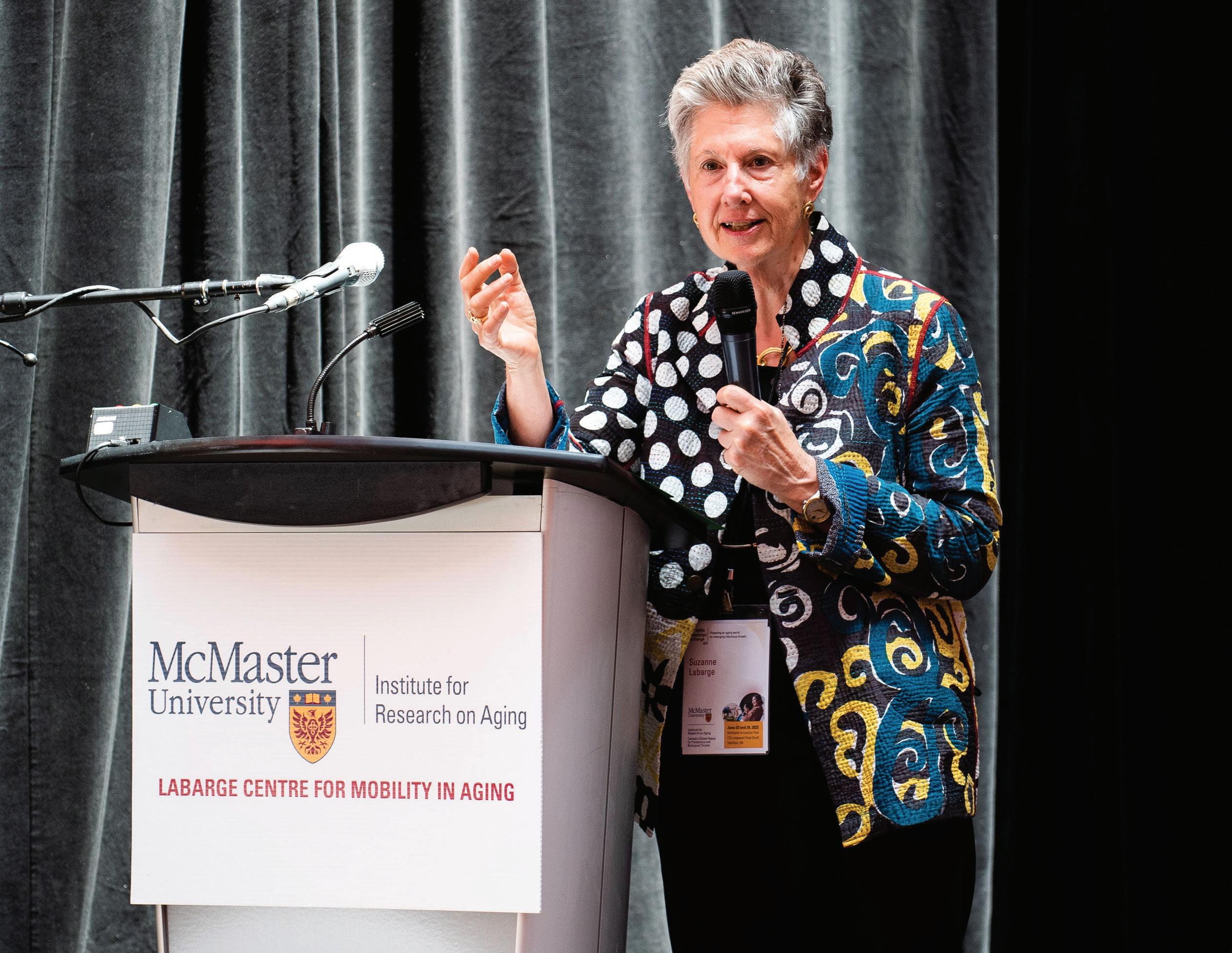MIRA and Labarge Annual Report



Labarge Centre for Mobility in Aging




Centre Institute for Research on Aging
MIRA | Dixon Hall

Table of contents









Labarge Centre for Mobility in Aging




Centre Institute for Research on Aging
MIRA | Dixon Hall






Today, there are more than seven million people in Canada over the age of 65. That is, more than seven million reasons to celebrate.
For the first time in history, many generations of the same families are living at the same time. This allows us to connect and understand the experiences of families across generations, from grandparents to their children and grandchildren, as we are doing through the MIRA-iGeN program. At the same time, many people are staying mobile for longer, something the MacM3 study is helping foster and build upon. While COVID has continued to be difficult, we saw great resilience from older adults and their communities this year. The EMBOLDEN program is drawing on that resilience as well as the many great services offered in our communities to connect people with local supports for healthy aging. The Labarge Centre for Mobility in Aging (LCMA) and the MIRA | Dixon Hall Centre, our two research centres, each saw great success in fostering new connections and developing research that is meaningful in the lives of older adults, their families, communities and society.
I have always been impressed by the work produced by McMaster’s broader research community. In 2022, we embarked on a significant undertaking alongside colleagues at Canada’s Global Nexus for Pandemics and Biological Threats and a team of Indigenous scholars. Together we created RAPPID: Readying Aging Populations for Pandemics and Infectious Disease and sought significant funding from the Canada First Research Excellence Fund. While our application was not funded, I am proud of what we collectively accomplished by bringing together a large and interdisciplinary team around all aspects of aging and infectious disease.
This year, MIRA built on the leading mobility work happening at the LCMA by collaborating with the World Health Organization (WHO). With partners at the WHO, we are producing systematic reviews on mobility in community dwelling older adults and are proposing a WHO-MIRA framework for measuring older adult mobility. Deepening our collaboration and global impact, MIRA is applying to bring a WHO collaborating centre on aging to McMaster.
Thank you to our members, trainees, staff and community members — your collective commitment and creativity drives the ambitious research of MIRA and our two research centres. This work would not be possible without Suzanne Labarge, McMaster’s former chancellor, who has generously given us vision and support since we began. Thank you, Suzanne.
Dr. Parminder Raina Scientific Director of the Labarge Centre for Mobility in Aging, MIRA | Dixon Hall Centre and the McMaster Institute for Research on Aging
Through leading-edge research, training and stakeholder collaboration, the McMaster Institute for Research on Aging (MIRA) is working to optimize the health and longevity of Canada’s aging population — while upholding the values of integrity, excellence, collaboration, inclusion and transparency. MIRA supports interdisciplinary research teams from across all six McMaster Faculties and research that directly engages older adults, their families, health care providers and other key stakeholders at every stage of activity. The MIRA approach is, from the outset, optimized to create useable, practical, older adult-centred solutions that promote aging in place.
Much of MIRA’s research support flows through two focused research centres — the Labarge Centre for Mobility in Aging (LCMA) and the MIRA | Dixon Hall Centre. These centres connect diversely skilled researchers and trainees around the most pressing questions in aging. To optimize the well-being of Canadians, the LCMA examines the biological, behavioural, technological and environmental factors that can affect individual and community mobility in older adults. The MIRA | Dixon Hall Centre was formed in partnership with Toronto’s Dixon Hall, a multi-service agency supporting older adults. This collaboration is enhancing research with, and services for, older people facing housing insecurity, barriers to transportation and transitions in care, such as hospital-to-home and at end-of-life.
Both research centres are made possible with the generosity of Suzanne Labarge, McMaster’s former chancellor.
MIRA membership by faculty affiliation
179
46
MIRA members represent 46 departments at McMaster.
All 6 McMaster Faculties are represented by MIRA members
141
The MIRA trainee network has 141 members. 45 new trainees joined in 2022.
■ Business
■ Engineering
■ Health Sciences
■ Humanities
■ Sciences
■ Social Science
■ External
MIRA has 179 members. In 2022, 26 of them were early career researchers.
141
In 2022, 141 highly qualified personnel (HQP) were supported by funded projects (in addition to HQP supported through MIRA/LCMA scholarships).
■ Research staff 70
■ Undergraduate students 24
■ Master’s students 15
■ PhD students 22
■ Postdoctoral fellows 10
In 2022, MIRA and Labarge supported aging research at McMaster with:
■ Labarge Catalyst Grants
Since 2016, MIRA, the LCMA, and Labarge Optimal Aging Initiative-funded projects and initiatives have raised an additional $33 million from internal and external source to support their ongoing work.
■ MIRA & Labarge Trainee Funding
4 Postdoctoral fellows
1 PhD scholarship
2 Master’s scholarships
6 Undergraduate fellowships
In 2022 alone, projects reported leveraging their MIRA and Labarge funding to attract a further of $3,739,924 in additional cash support.
■ CIHR $1,637,125
■ SSHRC $648,897
■ NSERC $105,000
■ NFRF (tri-council) $248,000
■ Other external agencies $900,902
■ Matched and Co-funded Opportunities
3 trainees (MSc, PhD, & PDF) with AGE-WELL
1 PhD student with IPRC
1 PhD student with Global Nexus
6 Labarge Catalyst Grants in Mobility in Aging — supporting a project led by each Faculty $240K $272K $133K
Some of these funding successes include:
■ Other McMaster internal $200,000
1 Biology of Aging Catalyst Grant with Global Nexus
1 Aging & Pain Catalyst grant with IPRC
2 Canadian Frailty Network grants supported with matching cash
■ Capacity Building & Engagement
2 Planning Grant-funded trainee capacity building workshops
1 award for development of the Aging and Mobility Human Conversation eXchange (iAM Human)
$937,125 from CIHR to support a project led by Stuart Phillips working with the MacM3 cohort
$446,847 from SSHRC for a project that builds on Carmela Laganse’s 2021 LCMA Catalyst Grant
$202,000 from SSHRC for a project led by Milena Head that extends work started through a MIRA Postdoctoral Fellowship
$242,000 from NFRF for a project led by Ivona Kuˇcerová and Andrea Gonzalez that builds on Gonzalez’ 2018
LCMA Catalyst Grant
Over $3.7M leveraged in 2022 $54K
$138,000 from McMaster’s Future of Canada Project to continue Victor Kuperman’s 2019 LCMA Catalyst Grant work
• Inclusive Spaces for Aging Well
• Aging Communities & Infectious Dangers: Are we prepared for what may come next?
• MIRA | Dixon Hall Centre Nordic Pole Walking Community Event & Research Symposium
3 Major public events
16 Research seminars and workshops
• Sessions included major research planning workshops facilitated by MIRA, One Topic, Two Disciplines seminars (on precarity in aging and supporting older women in ways that work) as well as four talks by visiting international scholars.
2 Major knowledge mobilization events
2,656
• MIRA & Labarge Knowledge Exchange
• MIRA & Labarge Catalyst Grant Symposium

This year, the Labarge Centre for Mobility in Aging supported a new set of ambitious projects through catalyst grants and trainee funding on topics including the experiences of Black Canadians living with dementia, integrating motion capture and mobility sensing technology into orthopaedic clinics, online misinformation with older adults and more. In the fall of 2022, MIRA and the LCMA hosted an in person Labarge Catalyst Grant Symposium for the first time since the beginning of COVID. Bringing together MIRA’s interdisciplinary research community, the event included trainee posters, presentations by 2022’s six newly funded catalyst grant projects and catalyst grant recipients from past years who spoke about the successes enabled by their LCMA funding. Bringing years of experience researching the mobility of older adults, MIRA researchers have partnered with the World Health Organization to create a framework for measuring mobility for older adults living in the community. This work began in October 2021, but continued through 2022. The project includes systematic reviews on the psychometric properties of life space and patient-reported mobility. MIRA is also in discussion with the WHO to bring a WHO collaborating centre on aging to McMaster, through MIRA.
Now in its second year, the MIRA | Dixon Hall Centre is working to support some of Toronto’s most vulnerable older adults through the generation of knowledge and development of programs that aim to improve quality of life and enable older adults to live with dignity. In 2022, relationships between MIRA and Dixon Hall continued to deepen and many new activities gained momentum and were implemented at Dixon Hall — including the EMBOLDEN and MacM3 MIRA major programs of research and the MIRA-iGeN intergenerational study. In September, the Centre held its first event, bringing together Dixon Hall staff, MIRA researchers and over 40 community members to learn more about the Centre, the McMaster Optimal Aging Portal and Nordic pole walking, which has led to the Strides for Health program that launched in 2023. This year, Marla Beauchamp was named the inaugural associate scientific director of the MIRA | Dixon Hall Centre. Beauchamp is the project lead of MacM3, a physical therapist and an associate professor in the School of Rehabilitation Science.

The first three of MIRA’s major programs of research saw success and progress throughout 2022. This year, the EMBOLDEN team completed their first project phase, which was focused on the co-design aspects of the program. Now in Phase 2, the team is conducting a pragmatic randomized controlled trial. EMBOLDEN is also working with partners in Toronto, including Dixon Hall, to bring the project there. In May 2022, MacM3 began recruiting for their large cohort study, which, among other measures, uses smartwatches to measure older adults’ mobility every four months over two years. MacM3 continues to deepen relationships with Dixon Hall and plans to recruit at least 500 participants by working with collaborators there. The
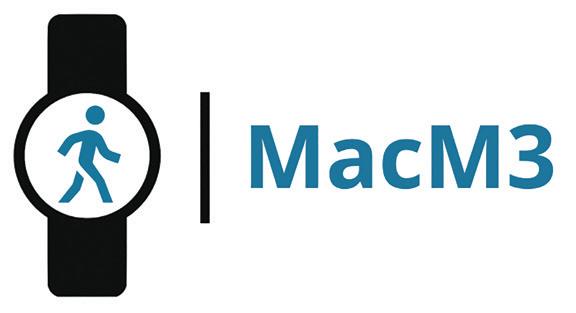



Patients project has tested the feasibility and wearability of activity sensing devices — finding that all 50 participants were able to wear the devices for 24 hours in hospital without and adverse events. The team in now working on a machine learning algorithm to classify and record mobility data. A second cohort of major programs of research is now in development. These programs will investigate intergenerational approaches to aging; complex interventions for frailty; and aging, technology and digital equity.
This year, MIRA continued to focus on direct community engagement through consultation, intergenerational education opportunities and knowledge sharing events. Four community consultations were hosted by MIRA, bringing community into the development of new research proposals around intergenerational aspects of aging, digital equity and access and the connection between aging and infectious disease. On average, 16 community members joined each session. MIRA continued to engage with its Stakeholder Committee around partnership opportunities and the Institute’s strategic planning process. MIRA also regularly engaged its Community Partner Network and looks forward to involving the network more deeply in the strategic planning process in 2023. With partners from Newcastle University and the United Kingdom’s National Innovation Centre for Ageing, MIRA is working to bring the Voice platform to Canada. Voice is an online community of older adults, caregivers and members of the public who contribute their lived experiences to help identify priorities and unmet needs by participating in research and research design opportunities. Through the very successful public events, Inclusive Spaces for Aging Well and Aging Communities & Pandemic Lessons: Are we prepared for the next infectious threat? MIRA helped share with the community updates on some of the latest and most pressing issues in aging research.
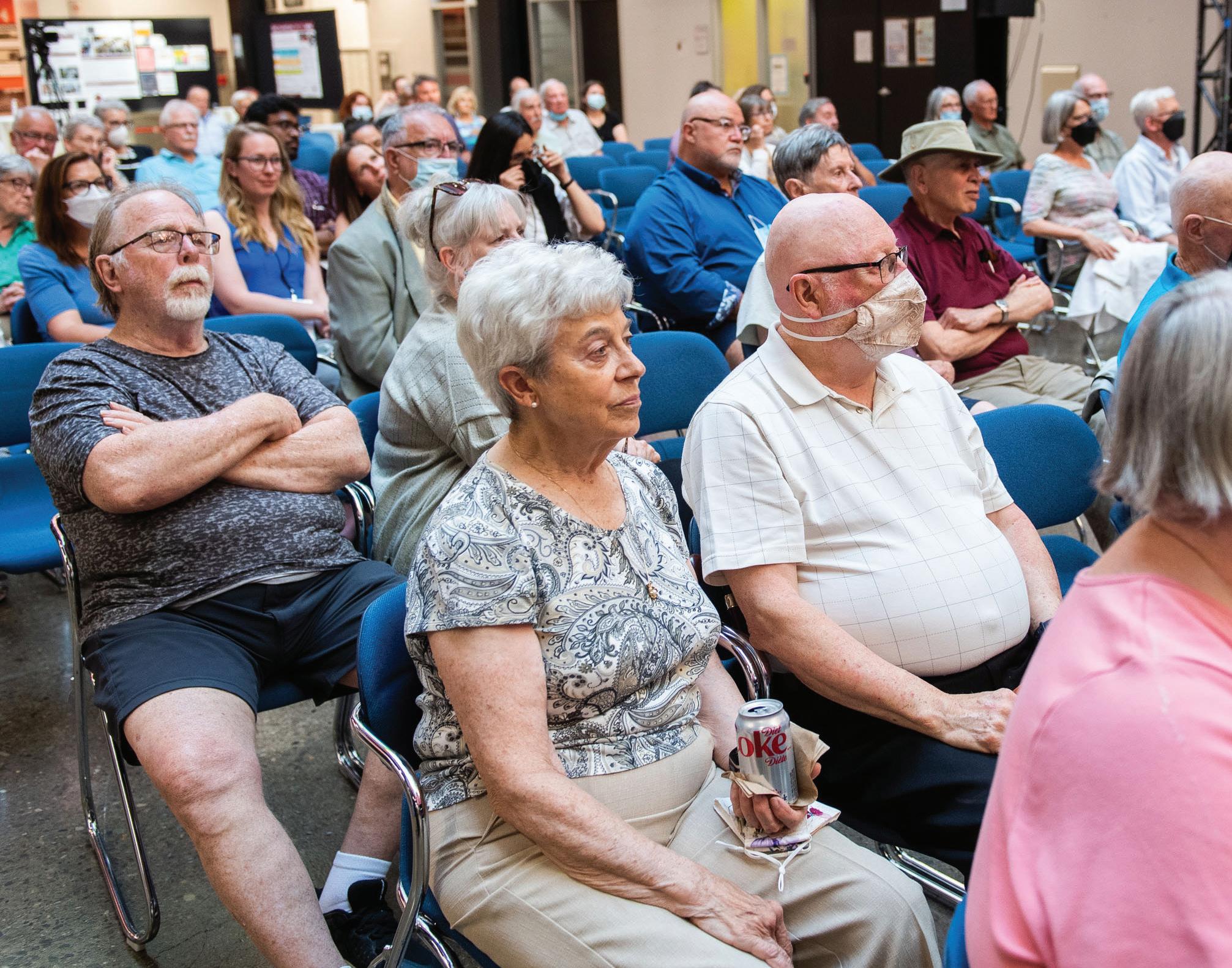



Impact, Ambition and Transformation through Excellence, Inclusion and Community: Advancing Human and Societal Health and Wellbeing. That is McMaster’s vision, and aging across the lifespan, one of the university’s key research priorities, is a critical part of making that ambitious vision come to life.
McMaster is ranked among the top 85 universities in the world and is one of the most research-intensive universities in Canada. As an Age-Friendly University, our world-class researchers are focused on advances that meaningfully improve the lives of older adults and their caregivers by connecting ideas across disciplines.

This report outlines many of the research, training and community engagement successes led and supported by MIRA in 2022. These accomplishments were made possible by the vision and generosity of Suzanne Labarge, McMaster’s former chancellor, and by the collaborative, interdisciplinary spirit MIRA and McMaster embody — connecting researchers, trainees and staff across all six McMaster Faculties, and centering the voices of community members.
Every day, MIRA members are finding medical, technological, cultural, economic, scientific, and societal solutions to the complex problems related to aging. Through this work, our members are making an impact and transforming the experience of aging in our community, our country and the world.
Through the hard work of MIRA’s members, trainees and staff, McMaster continued to grow in 2022 as a leader in aging research that is ambitious, responds to the needs of aging populations, solves real problems and matters provincially, nationally and internationally. And, MIRA’s community partners continued to provide the depth of vision and purpose that allows our research impact to resonate far and wide.
I am proud to be one of the many people championing aging research at McMaster. We have seen how, through the Labarge Centre for Mobility in Aging and more recently, the MIRA | Dixon Hall Centre, our researchers are building on the resilience and strength of older adults to improve lives and support people as they age. These successes are enabled by the generous investments made by Suzanne Labarge — a tireless advocate for excellence in aging research and ally to our researchers.
I hope you enjoy reading this report and seeing the many ways MIRA and its research centres continued to ambitiously push forward our understanding of aging and mobility in 2022.
Executive Vice-Dean and Associate Vice-President, Academic Faculty of Health SciencesUniversity Lead, Labarge Centre for Mobility in Aging, MIRA | Dixon Hall Centre and McMaster Institute for Research on Aging
Dr. David Farrar President and Vice-ChancellorMIRA’s governance and management structure has ensured scientific excellence and management as well as oversight from both the Labarge Gift Board and University senior leadership.
MIRA’s scientific director reports to the MIRA Governing Board and the Labarge Gift Board. The scientific director is advised by the Executive Committee and the International Scientific Advisory Committee. The leadership of each research centre has a seat on the Executive Committee. The Working Groups and the Stakeholder Committee and Community Partner Network provide a variety of perspectives to support MIRA’s research initiatives and programs.
In 2022, MIRA updated its terms of reference and renewed the membership of several governance committees. MIRA | Dixon Hall appointed Marla Beauchamp as the Centre’s inaugural associate scientific director to work closely with MIRA and Dixon Hall leadership on bridging the gap between academia and the community while supporting the development of future leaders.
It is my great honour to chair MIRA’s International Scientific Advisory Committee (ISAC). With the other members of ISAC, I strive to support MIRA’s important work, which is furthering our global understanding of aging while directly impacting the health and well-being of older adults in local communities.
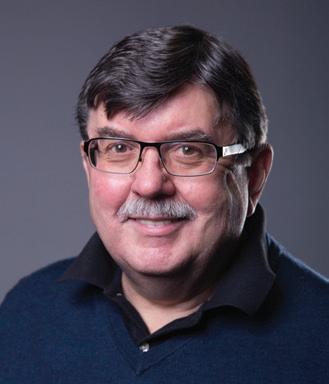
This year, the ISAC advised MIRA on advancing its renewed strategic framework, which builds on MIRA’s successes since its establishment in 2016. We were also excited to review and provide feedback on MIRA’s second cohort of major programs of research that will look at intergenerational approaches to aging and mobility; complex interventions for frailty; and aging, technology and digital equity. We have full confidence they will add to MIRA’s already enviable international reputation.
On behalf of the ISAC, I would like to thank our retiring Committee members, Drs. James Nazroo (University of Manchester) and S V Subramanian (Harvard University). Their contributions to our collective work have been invaluable. Concurrently, I would like to welcome Drs. Agneta Malmgren Fänge (Lund University), Luis Miguel Gutierrez Robledo (Instituto Nacional de Geriatría) and Wendy Rogers (University of Illinois Urbana-Champaign) to the Committee. Their expertise will help shape in novel ways MIRA’s future initiatives.
MIRA is important to the field of aging research in Canada and internationally. I am excited to see how MIRA will continue to have a positive influence on policy, science and the lives of older adults.
Dr. David Hogan, University of CalgaryLegend of Faculties
BUS DeGroote School of Business
ENG Faculty of Engineering
FHS Faculty of Health Sciences
HUM Faculty of Humanities
SCI Faculty of Science
SOSCI Faculty of Social Sciences
To better understand and improve complex issues in aging, MIRA assembles and facilitates interdisciplinary teams of researchers and knowledge users through major programs of research.


Beginning in 2017, MIRA researchers identified two major research themes that would benefit the aging population: exercise, nutrition and mobility in aging; and technology, environment and mobility in aging. In 2019, MIRA and the LCMA developed world-class research programs focused on directly impacting the lives of older adults and their caregivers in these crucial areas, with projects concentrating on physical mobility and social participation, assessing early mobility limitations through technology and promoting mobility during hospitalizations.
In 2021 and 2022, a second cohort of major programs of research was put into development. Exploring intergenerational approaches to aging; complex interventions for frailty; and aging, technology and digital equity, these projects will investigate the interconnected ways that aging affects individuals in families, in communities and in the digital world.
As MIRA’s major programs of research grow and evolve, the knowledge gained directly impacts the aging population, who are involved in project design from inception. From the ground-up, applying the principles of design thinking, these programs are uniquely poised to champion the involvement and benefit of the end-user. As MIRA continues to develop new major programs of research to address the complexities of aging, thoughtfully designed programs answer the question of how to age well at home, in hospital, in the community and in the digital world —now, and for years to come.
Physical mobility and social participation can help maintain independence and quality of life for adults 55 years of age and older. Through EMBOLDEN, interdisciplinary researchers partnered with local older adults and community service providers to co-design an innovative evidence-informed community group-based program to promote mobility amongst community-dwelling older adults living in neighbourhoods facing health inequities. Key program components include strengthening knowledge, skills and behaviours related to physical activity and healthy eating; fostering social connections; and facilitating system navigation. The three-month program is designed to allow tailoring to individuals’ needs and neighbourhood contexts and be jointly delivered by public health, primary care and social service providers.
In early 2022, the EMBOLDEN team completed Phase 1 of the study — co-design. Now in Phase 2, the team is conducting a pragmatic randomized controlled trial that is focusing equally on effectiveness and implementation outcomes. As a pragmatic and sustainable approach to this work, strategic partnerships have been arranged for existing community providers to deliver the EMBOLDEN intervention.
Recruitment in Hamilton launched in May 2022 with a small pilot in the Strathcona neighbourhood where a Community Advisory Board (CAB) of older adults and local community organizations provide strategic advice on neighbourhood-level implementation and adaptations. A trial in Hamilton’s Durand neighbourhood is now underway with additional neighbourhoods planned for 2023.
A system navigation tool (GENIE) has been established through considerable work by the team. This included working closely with the Hamilton Public Library (HPL) and GENIE’s developers at the University of Southampton to ensure seamless integration between the system and HPL’s RedBook information system. The tool is McMaster’s first project launched with Microsoft Azure for data security, laying important groundwork for legal agreements, dashboard analytics, and payment schemes for future projects.
Maggie MacNeil, an LCMA-funded postdoctoral fellow, led a developmental evaluation of partner engagement in EMBOLDEN’s Strategic Guiding Council (SGC), identifying strengths, limitations and impacts of the SGC on EMBOLDEN. The findings have helped refine partnership and communication strategies over time.

The EMBOLDEN team continues to build relationships and meet regularly with teams from Dixon Hall and Health Commons Solutions (PHAC Neighbours project) in Toronto. In winter 2023, EMBOLDEN will initiate strategic partnership meetings with key agencies in Toronto (beyond Dixon Hall) to prepare to deliver in Toronto’s downtown east.
• Rebecca Ganann (NPI), FHS
• Stuart Phillips, SCI
• Courtney Kennedy, FHS
• Bruce Newbold, SCI
• Elizabeth Alvarez, FHS
• Sarah Neil-Sztramko, FHS
• Ayse Kuspinar, FHS
• Diana Sherifali, FSH
• James Gillett, SOSCI



• Marla Beauchamp, FHS
• Julia Abelson, FHS
• Parminder Raina, FHS
• Lehana Thabane, FHS
• Terry Flynn, HUM
• Gina Agarwal, FHS
• Meridith Griffin, SOSCI
• Pasqualina Santaguida, FHS
• Chris Verschoor, FHS
• Gillian Mulvale, BUS
• Elizabeth Orr, FHS
• Ivaylo Vassilev, FHS
The EMBOLDEN trial: Enhancing physical and community MoBility in OLDEr adults with health inequities using commuNity co-design of a complex intervention incorporating exercise, nutrition, social participation and system navigation
• Marla Beauchamp (NPI), FHS
• Qiyin Fang, ENG
• Ayse Kuspinar, FHS
• Paul McNicholas, SCI
• Bruce Newbold, SCI
• Julie Richardson, FHS
• Darren Scott, SCI
• Brenda Vrkljan, FHS
• Manaf Zargoush, BUS
• Parminder Raina, FHS
• Paula Gardner, HUM
• Fei Chiang, ENG
• Jamal Deen, ENG
• Rebecca Ganann, FHS
• Saiedeh Razavi, ENG
• Ann Fudge Schormans, SOSCI
• Ravi Selvaganapathy, ENG
• Jinhui Ma, FHS
• Pasqualina Santaguida, FHS
• Norm Archer, BUS
• Vanina Dal Bel lo-Haas, FHS
• Meridith Griffin, SOSCI
• Lori Letts, FHS
• Julia Abelson, FHS
• Nigar Sekercioglu, FHS
• Rong Zheng, ENG
• Reza Samavi, ENG
• Stuart Phillips, SCI
• Evelyne Durocher, FHS
• Thomas Doyle, ENG
• Sarrah Lal, FHS
The MacM3 research program addresses issues specific to early mobility limitation in older communitydwelling Canadians through four interrelated projects. The first project was a qualitative study to understand older adults’ perception of the earliest changes in their mobility. The analysis from these interviews remains ongoing. The second project, which was completed in 2022, included a scoping review and international consensus exercise to determine how best to define and measure early mobility problems in later adulthood. In a third project, the MacM3 team has applied advanced statistical and machine learning techniques to data from the Canadian Longitudinal Study on Aging (CLSA) to find the most relevant predictors of early mobility problems.
The fourth project is the large MacM3 cohort study. This study uses smartwatch technology to measure mobility every four months for two years with 2000 adults aged 65 to 80 years. Recruitment began in Hamilton in May 2022 and so far, 503 participants have consented to participate, with 446 completing the baseline inperson physical assessments. This baseline assessment includes tests of basic mobility, physical assessments (such as lung function, vision) and questionnaires about health care utilization and physical, mental and social health. Four-month follow-up appointments started in September 2022. To date, 238 participants have been contacted. Analysis of the rich MacM3 dataset on mobility and health data obtained from MacM3 will be used to develop the M3 mobility tool in collaboration with older adults and their caregivers to help manage late-life mobility problems. The M3 tool will assess and depict an individual’s trajectory and risk for mobility decline based on key indicators. In the coming year, MacM3 will continue to deepen the project’s collaboration with Dixon Hall, with plans to recruit a minimum of 500 participants.
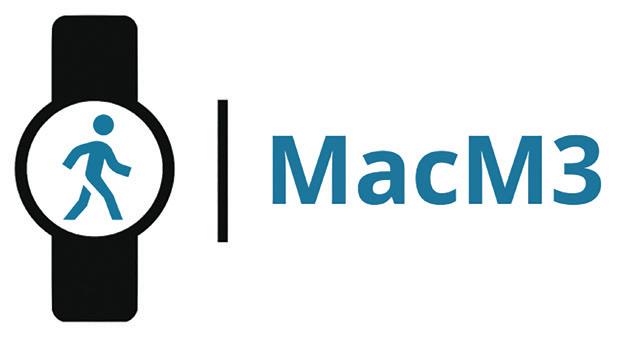
This year, a new project led by Stuart Phillips and Marla Beauchamp successfully leveraged the MacM3 study cohort to receive nearly $1 million from the Canadian Institutes of Health Research to look at the prevalence and health impact of muscle loss in older adults.

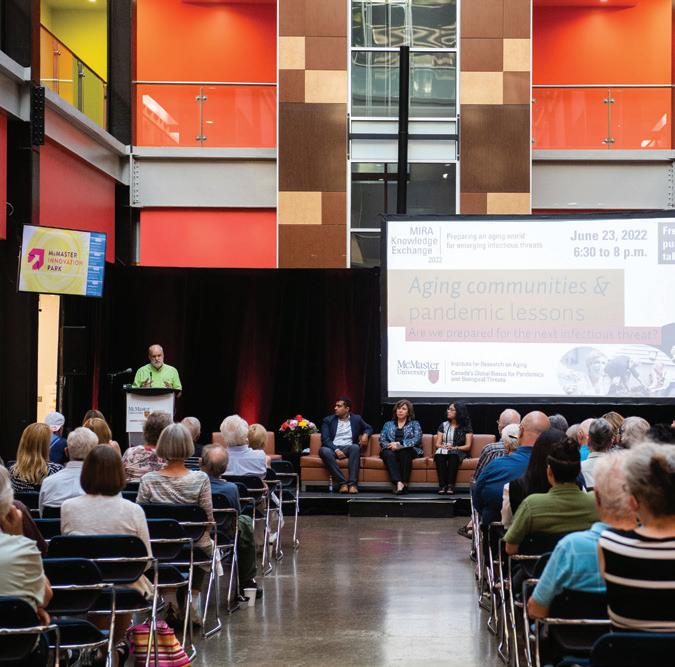
Older adults hospitalized for acute medical problems are at risk of significant functional and mobility decline during hospitalization. This can lead to prolonged hospital stays, high readmission rates and post-discharge institutionalized care. Early mobility programs (EMP) show some, but inconsistent, benefits across studies, suggesting a more tailored approach is needed. Wearable sensing technology that collects continuous mobility data may provide the granular detail to help characterize the relationship between mobility and functional and health outcomes for hospitalized older adults. This knowledge will help to identify patient trajectories associated with mobility limitation during hospitalization and inform how to best mitigate adverse outcomes by adapting health-care practices related to mobility.
Thus far, the project has assessed the feasibility and acceptability of wearable activity sensing devices. In 50 older adults, the researchers found that all participants were able to wear and keep these devices on for 24 hours while in hospital without adverse events. The mobility data was good quality and validated against direct observations. The team is developing a machine learning algorithm to classify the recorded data into the activities of sitting, walking and lying. They are now analyzing and validating the algorithm and preparing a report for peer-reviewed publication.

These findings will set the stage for the development of a customized wearable device that integrates mobility sensing technology with Onboard Machine Learning algorithms to provide point-of-care assessment, predict mobility trajectory and customize EMPs to help mitigate poor outcomes. The team will seek external funding to support the next phase of research, a larger study to compare the impact on mobility and health outcomes of EMP and no EMP.
• MyLinh Duong, FHS
• Lauren Griffith, FHS
• Rong Zheng, ENG
• Nick Miller, ENG
• Manaf Zargoush BUS
• Marla Beauchamp, FHS
• Paul McNicholas, SCI
• Jennifer Kodis
• Samir Raza, FHS
• Ameen Patel, FHS
• Jinhui Ma, FHS

• Kathryn Fisher, FHS
• Parminder Raina, FHS
Women growing older: Older women’s experiences of accessing cannabis information and support through virtual community

While older adults are now the fastest growing group of cannabis consumers since the 2018 legalization of cannabis in Canada, very few studies explore the social dimensions of cannabis consumption among this population. It is still unclear why older adults consume cannabis, how cannabis consumption impacts their mobility, and how and where older adults access cannabis-related information and support (both virtually and in-person).
To begin to answer these questions, this research assembles an interdisciplinary team of scholars in the social sciences, humanities, and health sciences, as well as older women-identified community researchers with lived experience of consuming cannabis. This pilot project aims to collaboratively create a virtual research community to engage older women in developing their own Cellphilm, a video created using a cellphone or tablet, to answer the following questions:
1. How do older women understand their cannabis consumption in relation to their physical and community mobility?
2. What are facilitators and barriers in seeking information and knowledge about cannabis?
3. What are the technological possibilities for supporting older women who consume cannabis’ physical and community mobility needs via virtual communities?
Grounded in a feminist participatory arts-based research approach that infuses feminist perspectives with participatory and actionoriented research processes, this study will work with six participants who identify as older or aging women (trans and femme nonbinary inclusive) who consume cannabis to participate in a 10-week virtual Cellphilm workshop over Zoom. At the end of the project, each participant will have created a Cellphilm that uniquely tells a story about the complexities of cannabis in relation to their physical and community mobility and the facilitators and barriers toward seeking out cannabis related information, knowledge, and support as a means to support their mobility. The participants’ Cellphilms will be knowledge dissemination tools to be screened to participants and more publicly for greater interrogation of this key social justice issue.
The experiences of Black Canadians living with dementia in the greater Toronto and Hamilton area and their care partners in providing care

INVESTIGATORS | Ingrid Waldron HUM, Pamela Baxter FHS, Margaret Fahnestock FHS, Lori Letts FHS, Jennifer Walker FHS, Ellen Badone SOSCI, Lydia Kapiriri FHS, Ngozi Ironyah and Anthea Innes SOSCI
This project brings together an interdisciplinary team of researchers in partnership with the Alzheimer’s Society of Canada. The Alzheimer Society has agreed to support the study by providing expertise and guidance; access to persons living with dementia where relevant; potential collaboration on knowledge translation activities and dissemination of findings.
The study has five objectives:
1. to examine the beliefs, perceptions, and attitudes that diverse Black Canadians living with moderate dementia in the GTHA hold about the illness, including how the determinants of mobility impact these beliefs, perceptions, and attitudes;
2. to learn about the experiences that diverse Black Canadians have living with dementia, including how the illness has impacted determinants to mobility, especially within the context of the COVID-19 pandemic;
3. to gain an understanding about the supports they use and the community activities they engage in to maintain and enhance their health and well-being (e.g. health and social services, sleep, hearing and vision, physical activity, nutrition and diet, and social interactions), including how the determinants to mobility shape their experiences accessing supports and activities, and how COVID-19 has impacted this;
4. to examine the experiences of their care partners in providing care, including any barriers they face providing care to address determinants to mobility, and how COVID-19 has impacted this; and
5. to use the data from objectives 1-4 to create a knowledge translation product or resource that will help inform future interventions that will restore, maintain, and promote mobility among Black Canadians living with dementia by addressing any structural barriers and gaps they face that prevent them from accessing and participating in the health care system and various spaces, opportunities, and activities due to the determinants to mobility and the pandemic.

Integrating innovative technologies into an orthopaedic clinic to support decision-making and personalized care: A feasibility study
Osteoarthritis (OA) affects millions of Canadians and involves a loss of joint cartilage and changes to nearby bone and soft tissue. This serious and incurable disease is also accompanied by increased pain, reduced function, and an overall decline in quality of life. The end stage treatment for OA is a total joint replacement, but identifying those most in need for this treatment is challenging. Assessing the movement and loading of the lower limbs during walking and functional task can be an excellent way to support clinical decisions for the ever-increasing number of older adults with this disease. Unfortunately, no previous technology offered a clinically viable method to do so. Thankfully, recent advancements in motion capture cameras, wearable sensors, and artificial intelligence have changed that, allowing researchers to accurately and efficiently collect this information in-clinic and during a patient’s daily activities.
Nevertheless, this state-of-the-art technology has yet to be incorporated in an orthopaedic clinic and there is a need to determine the feasibility and accuracy of this data before it can support clinical decision making. Therefore, the current project aims to implement these technologies at the Fracture and Orthopedics Clinic at St. Joseph’s Healthcare Hamilton and lay the foundation for a world-class translation research program that can provide clinicians with a complete picture of their patient’s joint function and specific deficits to ultimately facilitate innovations and customizations of treatment.
DRL-based physics modeling of aged locomotion for motion simulation, stability analysis and data augmentation
INVESTIGATORS | Yingying Wang ENG, Marla Beauchamp FHS and Dylan Kobsar SCI
Locomotion is critical to human mobility, allowing people to freely move in the physical world. Locomotion modeling has been one major topic in character animation research, where intelligent virtual avatars (IVAs) are trained to perform realistic motions in VR/AR and game applications. However, there is very little research effort dedicated to modeling movements for any demographic group, nor for health concerns and mobility study.
This project is the first work to learn physics models of age-specific locomotion through Deep Reinforcement Learning (DRL), for both motion simulation and mobility analysis purposes. One benefit of having intelligent physics models is that simulations and experiments can be performed through IVAs in the virtual world, without involving real humans in inaccessible or dangerous environments. The goal of this project is to learn intelligent physics models of locomotion for older adults, to conduct various mobility experiments, and generate a large synthetic locomotion dataset, through IVAs’ simulated motions in the virtual environment.
First, ground-truth locomotion from older adults of various age groups will be collected through mocap and provided as learning examples. Physics models will be trained using the state-of-the-art DRL method, to find optimal policies for IVAs to exert forces and torques to walk and run like the ground truth. Once trained, push-recovery and surface stability experiments will be conducted in the simulated environment, and report results from different age groups to understand human aging process. All IVAs with their trained physics models will be put into various virtual scenarios to simulate realistic locomotion for creating a large synthetic dataset.
This project will lead to publications of novel approaches for training age-specific physics models and findings from stability experiments. This project will also release the large synthetic dataset, which could benefit health researchers, computer scientists and animation artists.


A pilot randomized controlled trial of a virtual peer-support exercise intervention for older adults with cancer
By 2030, 23% of Canadians will be over 65 years of age. Two in five of these individuals will be diagnosed with cancer. Older adult females have high levels of functional decline, and a cancer diagnosis adds prolonged physical sequelae to the natural aging process. Many of these effects can be mitigated by regular exercise. However, older adult female cancer survivors are significantly less likely to meet current exercise guidelines than their younger counterparts. As populations age, there is a need to develop effective, scalable interventions that support health in older adult cancer survivors. The objective of this study is to determine the feasibility and preliminary effectiveness of a virtually delivered peer exercise intervention with qualified exercise professional (QEP) support for older adult female cancer survivors.
Participants will include older adult female cancer survivors who are cleared for exercise, have consistent access to the internet and currently take part in less than 150 minutes of exercise per week. All participants will be matched with a partner, given a peer support guide, and information on current exercise guidelines. In addition to being matched with a peer, dyads in the intervention group will have weekly virtual sessions with a QEP for 10 weeks. Participants in the control group will independently support their partner around exercise for 10 weeks.
Participants will be assessed at three time points. The primary outcome is feasibility. This will be measured by assessing recruitment, retention, adherence rates to the intervention, and participant acceptability and satisfaction. Secondary effectiveness outcomes include exercise volume, social support, quality of life, physical function, and physical activity enjoyment.
If effective, this will be the first virtual peer-based exercise intervention for older adult cancer survivors. Findings will inform future methods aimed at increasing exercise in older adults.


Digital communication technologies have great potential to enrich and transform personal, professional, and educational lives. Over the past decade, older adults have increasingly embraced digital life to stay connected. Their use of digital communication technologies has further accelerated during the pandemic as most social support programs had to move online. While technologies such as online social networking websites can provide older adults with essential support and connectivity, these platforms also facilitate the spread of misinformation which can threaten one’s wellbeing and mobility through harmful health information. Older adults are particularly vulnerable to this threat as they may have difficulty in detecting misinformation effectively due to decreased cognitive functions that are a natural by-product of aging. Being victimized by misinformation can lead to significant emotional, cognitive and financial burdens that impact the mobility and wellbeing of older adults. While this demographic has been recognized as being of high risk for misinformation, older adults are severely underresearched when it comes to the negative effects of technology use.
This proposed program of research will provide much needed understanding on how older adults are impacted by the technology threat of misinformation and how to design support to encourage resilience to misinformation that results in improved wellbeing and mobility for older adults. Specifically, this research aims to understand key antecedents to misinformation susceptibility for older adults from three perspectives: individual, medium and message characteristics. Based on these findings, this project will design and evaluate an educational program aimed to support older adults in their misinformation detection and coping. This will provide designers of technologies/platforms insights into detection and coping strategies that will mitigate the negative effect of misinformation on older adults. These insights can also help inform and direct public policy in combating IT threats.
Chronic neck pain (CNP) is a debilitating condition that decreases quality of life and has been cited as one of the globally leading causes of disability. CNP is persistent pain and heightened sensitivity of the neck lasting longer than three months without a preceding traumatic injury. Aging is associated with an increased prevalence and severity of CNP. Treatment options are limited and have moderate success.
In CNP, abnormal changes to the size and function of the brain area controlling the muscles of the neck are associated with pain symptoms. Treatment interventions aimed at restoring the brain area which controls the neck muscles may improve symptoms. The team has developed a brain-computer interface that simultaneously records brain and muscle signals using a technique called corticomuscular coherence (CMC). Pilot work indicates that participants can improve their CMC when provided with feedback. As the signal relates to communication between the brain and muscle, increasing the CMC value can improve synchronization between cortex and muscle.
The goal of this study is to determine if individuals with CNP can improve their pain symptoms through improving CMC. Forty individuals with CNP who are 45 years and older will participate in one of two equally sized groups. Both groups will participate in a proprioceptive head rotation task three to five days per week for four weeks. One group will experience the CMC feedback during the task and the other group will not. Researchers will evaluate the effectiveness of the novel CMC-brain-computer interface (BCI) using assessments of pain rating, activities of daily living and quality of life before and at one day and one month following the proprioceptive head rotation task. The team hypothesizes that pain symptoms will improve in both groups with greater change in the group receiving CMC feedback. This translational research is positioned to make significant advances in CNP treatment.
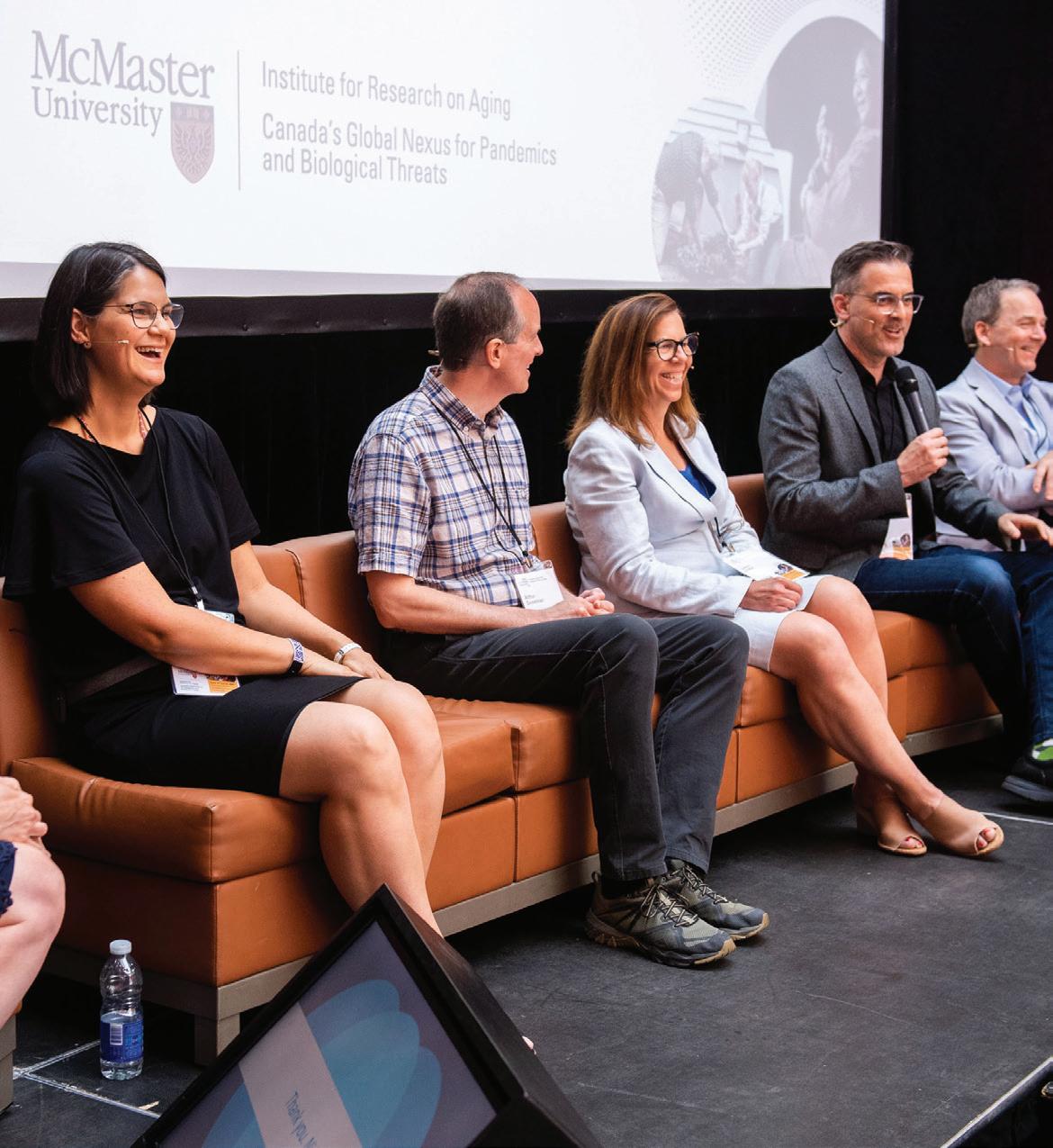
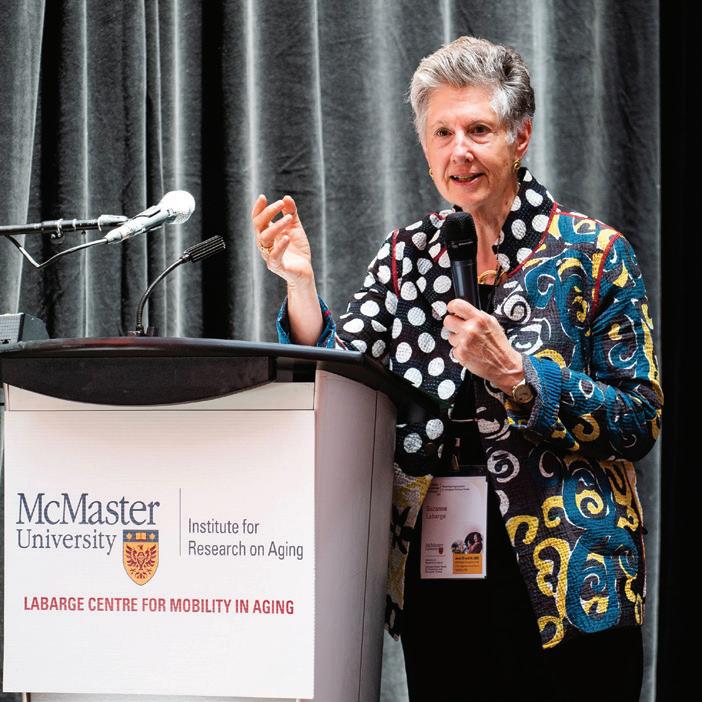
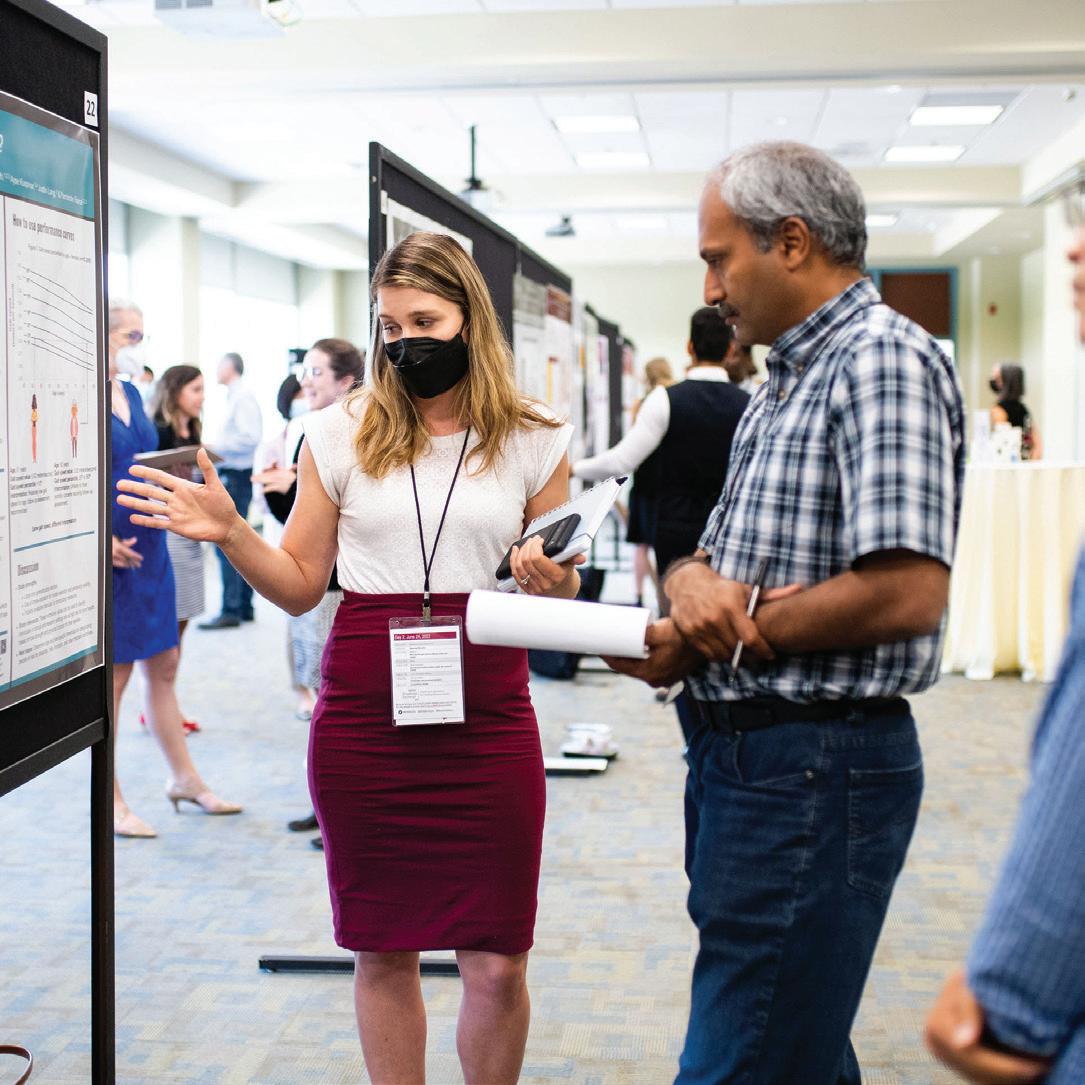

Older adults are more likely to be hospitalized or die from respiratory infections such as influenza, pneumonia and COVID-19. Vaccination is their best protection against severe infection, but vaccines rely on the immune system to work and older adults often do not have a fully functional immune system. This means that even if they are fully vaccinated, older adults may still get sick enough to need medical care. In fact, older adults are still the ones most likely to die of COVID-19, even if they are vaccinated. New treatments for infections in older adults that can help the aging immune system to function properly and fight infections need to be developed. Researchers have discovered that age-related changes in immune cells are caused by a combination of chronic inflammation and changes to how these cells turn their genes on and off. Excitingly, there is a drug that is currently used to treat some cancers of immune cells that might reverse some of the age-associated changes in immune cells and restore the immune system’s ability to fight infection. The team will use this drug at low doses in old mice to determine if it makes immune cells ‘young’ again and if it can help them fight infection. If this works, the project team may have discovered a drug that older adults can be given when they get sick to help their immune cells fight infection. This would mean there is another tool, in addition to vaccines, that would help treat infections.

The end-stage treatment for osteoarthritis is total joint replacement, a procedure that can be very impactful in the lives of many older adults. However, until recently there has not been a simple in-clinic way to assess how people’s legs move and how they carry the weight of a person’s body — key information that can support important treatment decisions. In this study, Kobsar and colleagues will outfit the hallway at the Fracture and Orthopedics Clinic at St. Joseph’s Healthcare Hamilton with an array of movement tracking cameras able to gather critical mobility data from participants directly following their meeting with clinicians. Previously, these assessments were only possible in specialized labs external to the hospital. To add depth to this information, data about the participant’s mobility in daily life is captured with wearable sensors. Together, this data gives clinicians a complete picture of the participant’s joint function to provide better, more tailored treatment.
PRINCIPAL INVESTIGATOR
Dylan Kobsar SCI
PRIMARY FUNDING SOURCE
$100,000
Canadian Frailty Network Springboard Grants Program
MATCHED FUNDUING
$40,000
Project supported through the Labarge Catalyst Grant in Mobility in Aging
Understanding how to properly manage swallowing difficulty is a critical issue for older adults, with up to one third of older adults experiencing swallowing difficulties. When not properly managed, these challenges can lead to a range of negative impacts on a person’s nutrition, health and quality of life. Older age and frailty may both be causes of swallowing difficulties, but no studies have used objective measures to assess swallowing and frailty. Namasivayam-MacDonald and colleagues will perform assessments of swallowing, frailty, physical function and physical activity with a group of older adults to understand the connections between these key factors.
PRINCIPAL INVESTIGATOR
Ashwini Namasivayam-MacDonald FHS

PRIMARY FUNDING SOURCE
$100,000
Canadian Frailty Network Springboard Grants Program
MATCHED FUNDUING
$20,000
Labarge Centre for Mobility in Aging matching funding
2021 | Labarge Catalyst Grant in Mobility in Aging
Enhancing digital literacy and online mobility for under-represented older adults: A pilot project with Arabic-speaking communities in Hamilton
INVESTIGATORS | Carmela Laganse HUM, Tara LaRose SOSCI and Brian Detlor BUS
Studying aging, mobility and chronic low back pain in older adults using remote monitoring
HIGHLIGHT | The relationships that researchers developed and expanded through this project informed a successful 2022 SSHRC RDGI grant of $446,847 to continue working with and learning from the expertise in our communities.
INVESTIGATORS | Harsha Shanthanna FHS, Aimee Nelson SCI, Jamal Deen ENG, Ravi Selvaganapathy ENG, Luciana Macedo FHS, Lisa Carlesso FHS, Lehana Thabane FHS, Mohit Bhandari FHS, Kim Madden FHS and Moin Khan FHS
Designing new futures: Co-creating housing and support pathways for “aging in community” to reduce premature long term care intake
INVESTIGATORS | Jim Dunn SOSCI, Michelle Wyndham-West SOSCI, Gina Agarwal FHS and Antonio Paez SCI
Long term care network capacity planning with considerations of equity, diversity and inclusion
INVESTIGATORS | Kai Huang BUS, Manaf Zargoush BUS, Andrew Costa FHS and Bruce Newbold SCI
Annotating virtual Tai Chi sessions to improve learning and health outcomes for older adults
INVESTIGATORS | Rong Zheng ENG, Brenda Vrkljan FHS, Lisa Carlesso FHS and Paula Gardner HUM
Improving physical and mental health via live online physical activity for older persons: A pilot randomized control trial
INVESTIGATORS | Stuart Phillips SCI, Ada Tang FHS, Meridith Griffin SOSCI, James McKendry SCI, Everson A Nunes SCI, Giulia Coletta SCI and Kenny Noguchi FHS
2019 | Labarge Catalyst Grant in Mobility in Aging
Movement sonification for testing mobility in the context of interacting with complex environments
INVESTIGATORS | Laurel Trainor SCI, Dobromir Dotov SCI, Marla Beauchamp FHS, Tara Packham FHS, Janie Wilson FHS, Qiyin Fang ENG and Matthew Woolhouse HUM
How can we improve mobility through alternative transportation modes for seniors? Measuring what works and what does not work in road safety improvements for pedestrians and cyclists
INVESTIGATORS | Michel Grignon SOSCI, Niko Yiannakoulias SCI, Emmanuel Guindon FHS, Tara Marshall SOSCI, Jean-EricTarride FHS and Mohamed Hussein ENG
Bioprinted 3D in-vitro models to determine mechanisms of cognitive benefits of exercise in the elderly
INVESTIGATORS | Ravi Selvaganapathy ENG, Margaret Fahnestock FHS, Aimee Nelson SCI and Christopher Patterson FHS
Born and raised in Hamilton – An intergenerational and life course program of research
INVESTIGATORS | Andrea Gonzalez FHS, Parminder Raina FHS, Harriet MacMillan FHS, Teresa Bennett
FHS, Marla Beauchamp FHS, Lauren Griffith FHS, Katherine Morrison FHS, Greg Steinberg FHS, Nick Kates FHS, Flavio Kapczinski FHS, Brenda Vrkljan FHS, Andrew Costa FHS, James Gillett SOSCI, Jim Dunn SOSCI, Stuart Phillips SCI and Jennifer Heisz SCI
Aging and mobility in nature: A McMaster and Royal Botanical Gardens collaboration
INVESTIGATORS | James Gillett SOSCI, Meridith Griffin SOSCI, Gavin Andrews SOSCI, Marla Beauchamp
FHS, Rong Zheng ENG, Nancy Bouchier HUM, Maryam Ghasemaghaei BUS, Manaf Zargoush BUS and Jennifer Heisz SCI
Addressing alternate level of care issue facing older Canadians: A co-designed comprehensive data analytics approach
INVESTIGATORS | Manaf Zargoush BUS, Alexandra Papaioannou FHS and Reza Samavi ENG
HIGHLIGHT | Project co-investigator Margaret Fahnestock and her trainees have received several awards related to this project, including $200,000 over two years from the HS Chau Foundation.
HIGHLIGHT | This funding catalyzed a collaboration for Andrea Gonzalez with fellow MIRA member Ivona Kuˇcerová. This collaboration led to a $248,546 New Frontiers in Research Fund Exploration Grant — Language revitalization in infants: Lullabies as a tool to promote intergenerational mobility, Indigenous health and community well-being.
HIGHLIGHT | This catalyst grant helped show a community partner, the Royal Botanical Gardens (RBG), that they could be involved in research with older adults. The team’s approach to working with the RBG allowed David Galbraith, the garden’s head of science, to advocate for an expanded role for research and collaboration with McMaster at the RBG.
HIGHLIGHT | Manaf Zargoush leveraged work from this catalyst project as a co-investigator on a new $600,000 grant from the Canadian Institutes of Health Research: Setting the balance of care for older adults at risk of hospitalization with a discharge delay.
Lifelike 3D cell culture constructs to investigate the role of branched-chain amino acids in type 2 diabetes in aging
INVESTIGATORS | Gianni Parise SCI, Mark Tarnopolsky FHS, Ravi Selvaganapathy ENG, James McKendry SCI, Josh Nederveen SCI and Changhyun Lim SCI
The #Caremongering social media campaign: Understanding its impact and adaptability to combat social isolation among older adults affected by COVID-19
INVESTIGATORS | Hsien Seow FHS, Teresa Chan FHS, Paula Gardner HUM, Allison Williams SCI, Sandra Moll FHS, Julia Abelson FHS, Harvey Chochinov, Barbara Pesut, Madelyn Law, Sara Urowitz, Shelly Cory and Susan Macaulay
The IMPACT Hamilton study — Investigating mobility and participation among older Hamiltonians during COVID-19: A longitudinal tele-survey
INVESTIGATORS | Marla Beauchamp FHS, Brenda Vrkljan FHS, Paula Gardner HUM, Heather Keller, Luciana Macedo FHS, Bruce Newbold SCI, Darren Scott SCI, Nazmul Sohel FHS, Elisabeth Vesnaver, Janie Wilson FHS and Mary Mills
2021 | MIRA-IPRC Catalyst Grant in Aging and Pain
Persistent post-surgical pain, postoperative cognitive dysfunction, and resilience in older people undergoing elective knee surgery: a mixed method project to explore associations and underlying mechanisms
INVESTIGATORS | Maura Marcucci FHS, Harsha Shanthanna FHS, Kim Madden FHS, Suzanna Becker SCI, Margaret Fahnestock FHS and Meridith Griffin SOSCI
2020 | MIRA-IPRC Catalyst Grant in Aging and Pain
Feasibility study to assess the added value of Integrated Musculoskeletal BioFeedback Device (IMBED) combined with neuromuscular exercise and education (GLA-D) to decrease chronic pain in older adults with osteoarthritis
INVESTIGATORS | Lina Santaguida FHS, Qiyin Fang ENG and Stu Phillips SCI
2018 | Matched Funding
ACHRU community partnership program for diabetes self-management for older adults — Canada
INVESTIGATORS | Maureen Markle-Reid FHS, Ruta Valaitis FHS, Diana Sherifali FHS and Janet Pritchard SCI
PRIMARY FUNDING SOURCE | CIHR Operating Grant: SPOR PIHCI Network: Programmatic Grants MATCHED FUNDING | $20,000
2017 | Matched Funding
Mobilizing a caregiver inclusive and accommodating workplace organizations standard: A partnership approach
INVESTIGATORS | Allison Williams SCI with multiple investigators from McMaster and other organizations
PRIMARY FUNDING SOURCE | CIHR Operating Grant: SPOR PIHCI Network: Programmatic Grants MATCHED FUNDING | $22,000
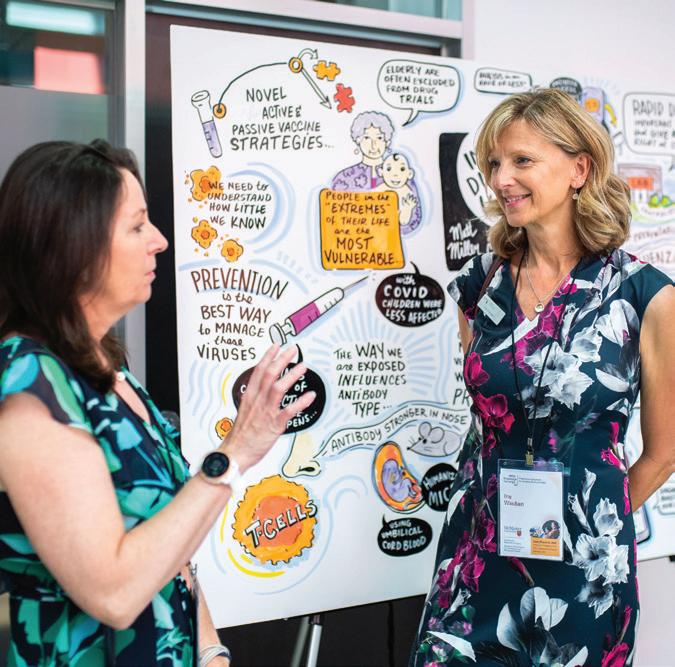
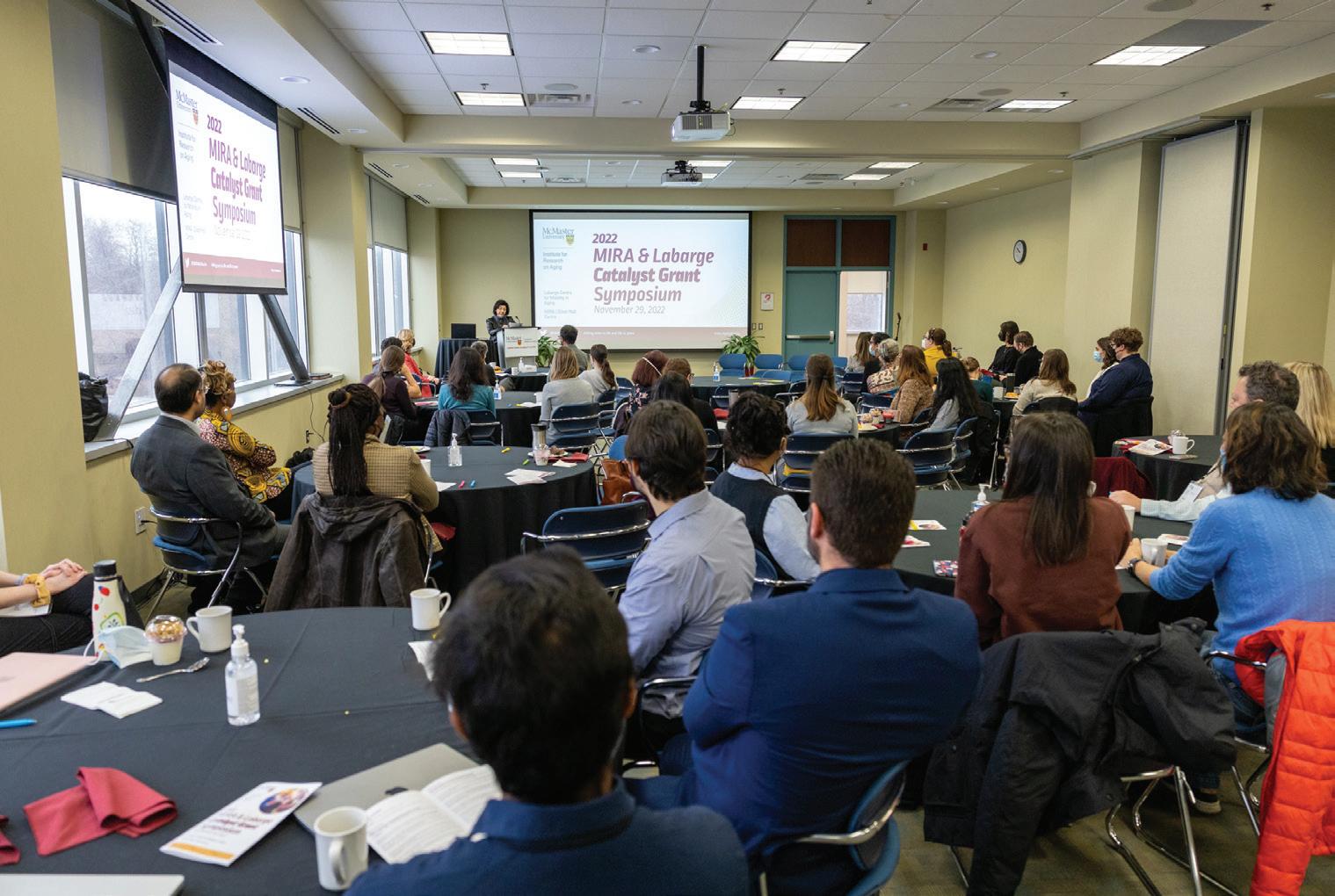
A multidisciplinary approach to addressing mobility limitations after orthopaedic joint replacement surgery
INVESTIGATORS | Janie Wilson FHS, Lisa Carlesso FHS, Luciana Macedo FHS, Cheryl Quenneville ENG, Elizabeth Hassan ENG, Rong Zheng ENG, Dylan Kobsar SCI, Manaf Zargoush BUS, Dan Tushinski FHS, Dale Williams FHS, Tom Wood FHS, David Wilson ENG, Anthony Adili FHS and Kim Madden FHS
HIGHLIGHT | The funding facilitated a permanent gait analysis system directly in an orthopaedic fracture clinic — leveraging the strength of the interdisciplinary team in bringing new technologies to study mobility outcomes in older adults who require orthopaedic care. This will allow researchers advance clinical decision-making to optimize mobility outcomes for patients and directly contribute to improving the health of older adults in Canada. This project has leveraged $328,250 in external funding.
Writing of age: Linguistic markers of cognitive, emotional and social well-being among older adults
INVESTIGATORS | Victor Kuperman HUM, James Gillett SOSCI, Ranil Sonnadara FHS and Aki-Juhani Kyröläinen HUM
HIGHLIGHT | LCMA catalyst funding enabled a successfully application for intramural funding from the Research Excellence Fund at McMaster and the Future of Canada Project by Wilson Foundation. Victor Kuperman attributes the renewal of his Canada Research Chair (Tier 2) in part to the success of this project.
Since 2016, MIRA has supported 18 teams by facilitating access to CLSA data
—
Four were supported in 2022
The MIRA Trainee Network supports graduate students, postdoctoral fellows and undergraduate research fellows from across all six McMaster Faculties. In 2022, the network welcomed 45 new trainees, bringing total membership over 140. Members of the Trainee Network supported and engaged in a variety of MIRA initiatives this year, attending MIRA seminars and events; answering participation and consultation calls from researchers and MIRA’s partners and sharing their work at monthly virtual and in-person trainee meetings. MIRA trainees presented 63 research posters at MIRA events, including the Inclusive Spaces for Aging Well community and research fair, the MIRA Knowledge Exchange and the Labarge Catalyst Grant Symposium. MIRA’s rich trainee network also bolstered the Institute’s presence at the Canadian Association on Gerontology (CAG) annual meeting in October 2022, presenting nine posters and talks. Here Stephanie Hatzifilatihis won the CAG Best Poster Award for “I like hearing the door close”: A critical realist case study of intergenerational co-housing.
Trainees also pitched and led their own initiatives, working with MIRA’s team to develop and deliver events and workshops through the MIRA Trainee Planning Grants mechanism. In 2022 these included the MIRA Trainee Grant Writing Workshop and Seminar Series led by PhD student Kenny Noguchi and a research co-design workshop led by PhD student Cassandra Thorne.
Legend of Faculties
BUS DeGroote School of Business

ENG Faculty of Engineering
FHS Faculty of Health Sciences
HUM Faculty of Humanities
SCI Faculty of Science
SOSCI Faculty of Social Sciences
MIRA trainees were also the subject of MIRA’s own scholarly activity. An interdisciplinary team of MIRA trainees and staff published “Interdisciplinary trainee networks to promote research on aging: Facilitators, barriers, and next steps” in Gerontology & Geriatrics Education (June 2022). MIRA presented a poster at CAG 2022 in Regina, describing the relationship between trainee projects’ interdisciplinarity, stakeholder collaboration and research impact measures.

The influence of age on cerebrovascular stiffness, cognitive function, and mobility
TRAINEE | Geoff Coombs SCI

SUPERVISORS | Baraa Al-Khazraji SCI and Jeremy Walsh SCI
MENTORS | Ada Tang FHS and Michael Noseworthy ENG

This study will evaluate structural integrity in brain blood vessels in middle to older-aged compared to young adults. It is hypothesized that cardiorespiratory fitness and physical activity levels are linked to structural changes in the brain (i.e., exercise is protective against cerebral small vessel disease, as evidenced by MRI findings). The secondary hypothesis is that cognitive and physical function are both negatively related to changes in brain structure in middle to olderaged adults and that cardiorespiratory fitness/physical activity levels offset the magnitude of structural decline in brain blood vessels and therefore protect cognitive/ physical function.
TRAINEE | Karla Martinez Pomier SCI
SUPERVISOR | Giuseppe Melacini SCI
MENTOR | Lesley MacNeil FHS

This project will examine how aging leads to harmful protein modifications and aggregation. This process is the basis for amyloid diseases and neurodegeneration. Human serum albumin, the most abundant protein in plasma and the cerebrospinal fluid, has a neuroprotective effect as an amyloid inhibitor, preventing the aggregation of amyloid proteins such as the A-beta peptide and alpha synuclein, which is related to Alzheimer’s and Parkinson’s respectively. It is hypothesized that upon aging the neuroprotective effects of albumin are compromised thus leading to the accumulation of amyloid proteins and the onset of neurodegenerative disorders. Through the examination of human serum albumin, this project aims to understand one of the mechanisms in the complex process of aging, that may support the development of new therapeutic opportunities.
SUPERVISOR
MENTOR | Jose Moran-Mirabal SCI
As people age, the levels of tumour necrosis factor (TNF) in their blood tend to increase. TNF is a major chemical messenger responsible for causing inflammation. Older adults with high levels of TNF in their blood are more likely to catch pneumonia. People with high blood TNF levels are also more likely to be admitted to the ICU or die after being hospitalised for pneumonia. TNF worsens the ability of immune cells called macrophages to destroy the bacteria that causes pneumonia. This purpose will explore how inflammation and TNF impair macrophage function. It will examine whether TNF can be targeted to improve older adults’ responses to infections and to understand whether higher levels of TNF in males explains their increased susceptibility to and death from pneumonia compared to females.
Understanding how aging leads to amyloid diseases and neurodegeneration2022 | MIRA Postdoctoral Fellowship 2022 | MIRA PhD Scholarship 2022 | MIRA and Global Nexus PhD Scholarship TRAINEE | Kevin Zhao FHS | Dawn Bowdish FHS
An interdisciplinary approach to understanding the biological pathways through which body composition impacts mobility: An analyses using longitudinal data from the Canadian Longitudinal Study on Aging
Understanding pain phenotypes in individuals with early knee osteoarthritis
SUPERVISOR
MENTOR | Sam Sadeghi SCI


Extensive cell death and dysfunction observed in the brain of aging individuals and Alzheimer’s patients is correlated with the loss of pro-Nerve Growth Factor (proNGF), responsible for maintaining healthy neurons, in the basal forebrain. Tropomyosin-related kinase A (TrkA) receptors expressed on basal forebrain neuron axon terminals bind, internalize, and transport proNGF produced in other brain regions. This process is essential for the survival and maintenance of basal forebrain neurons involved in learning, memory, and attention. Aged neurons grown in a petri dish (in vitro) show lower proNGF transport compared to young neurons. This finding strengthens the theory that reduced proNGF transport to the basal forebrain due to reduced TrkA levels causes neurons to lose their physical and functional integrity. While transport of proNGF by TrkA has been studied in vitro, this research aims to investigate TrkA expression and transport in vivo, in living mice.
SUPERVISOR
MENTORS | Jennifer Heisz SCI and Cheryl Quenneville ENG

Body composition markedly changes with age including muscle loss and fat accumulation. Common measures of body fat such as the body mass index (BMI) fail to capture age-related changes and have limited our understanding of the role of body composition in maintaining mobility in older adults. Data from the Canadian Longitudinal Study on Aging (CLSA) will be evaluated to determine if alternative measures of body composition (i.e. visceral adipose tissues and subcutaneous adipose tissue) better identify older adults at increased risk of poor health due to excess fat.
SUPERVISOR
MENTOR
Researchers have recommended early identification and treatment of knee osteoarthritis (KOA) and exploration of pain subgroups as strategies to minimise the longterm disease burden. The existing knowledge of KOA pain phenotypes is based on patients with established disease, and does not reflect impairments in patients with early KOA and relation to pain worsening. This project will explore pain phenotype models using pain variables alone and pain and clinical variables in patients with early KOA to inform the current debate about which approach (pain vs broad clinical) best predicts pain worsening two years later.
Is GDF15 important for the anti-aging effects of metformin?
The digital empowerment of vulnerable senior living: A case study of digital literacy training at CityHousing Hamilton
TRAINEE | Kaitlin Wynia Baluk BUS
SUPERVISOR
MENTOR | Bruce Newbold SCI
Mobility decline is often assessed in structured settings, using physical performance measures that can be limited in capturing the holistic nature of mobility. The Life-Space Assessment (LSA) was developed to account for the numerous factors that influence mobility in everyday life. Research has shown that limited life-space mobility in older adults is associated with decreased quality of life, increased morbidity, and increased mortality. However, reference data for the LSA and an assessment of its measurement properties are not available for Canada. This project aims to establish reference values and assess the measurement properties of the LSA in the Canadian Longitudinal Study on Aging (CLSA). This will help clinicians and researchers to interpret, compare, and make inferences on scores obtained in clinical and research settings, and encourage the use of the LSA.
SUPERVISOR | Gregory Steinberg FHS

MENTORS | Vladimir Ljubicic SCI, Stuart Phillips SCI, Saman Sadeghi SCI, Michael Noseworthy ENG and Guillaume Pare FHS
Aging is the leading risk factor for developing many deleterious chronic diseases, such as diabetes, heart disease, cancer, and Alzheimer’s disease. The type 2 diabetes medication metformin has been shown to delay the onset of many age-related diseases in mice and in cross-sectional studies in humans. How metformin exerts beneficial effects in so many tissues, despite acting primarily in the liver, is unknown. Metformin increases the production of a hormone called growth differentiation factor 15 (GDF15) which is upregulated in the blood of aging mice and humans. In animal models, GDF15 effects include a reduction in food intake, body mass, and inflammation. This project will examine whether GDF15 is critical for the antiaging effects of metformin and whether this involves the GDF15 receptor, by studying mice treated with metformin but lacking GDF15 and the GDF15 receptor.
SUPERVISOR | Brian Detlor BUS
MENTORS | Tara LaRose SOSCI and Carmela Laganse HUM


COLLABORATORS | Brenda Silverthorne, City Housing Hamilton, and Lisa Weaver, Hamilton Public Library
This project explores potential digital literacy training solutions for Hamilton older adults in social housing. The project is informed by Design Thinking. This study involved a qualitative research component about digital literacy and empowerment needs and training preferences, as well as the barriers older adults face to digital literacy. Results were shared with leadership at CityHousing Hamilton and Hamilton Public Library and were used to inform a federal grant application (Digital Literacy Exchange Program). In the second stage, findings from the first stage will be implemented to ideate potential digital literacy solutions for the target population and to plan a community-led digital literacy instruction program.
Remote monitoring of mobility and sleep patterns in older adults using context aware smart-home




Older adults who are frail are more likely to be sedentary. Prolonged sedentary time is associated with declines in mobility and quality of life, and increased risk of falls, fractures, and mortality. There is little research about the context of sedentary behaviour, about when and where to intervene, and which specific sedentary behaviours should be targeted. Some cognitively engaging sedentary behaviours may benefit health, while time spent in more passive activities may be harmful. Thus, interventions should specifically target sedentary behaviours that are associated with adverse events.
Remote health assessments using virtual technology can improve accessibility to health-care services. Walking speed is a physical assessment that can accurately predict negative health outcomes including falls and hospitalization. This study will develop and evaluate the feasibility, reliability and validity of a virtual walking speed test in older adults to improve the delivery of health services and support the regular monitoring of mobility.
The overarching goal of this research is to develop a low-cost, easily accessible smart-home indoor positioning system (IPS) that can be used for remote monitoring of mobility and sleep patterns in older adults to identify early-onset neurodegeneration markers for promoting safe aging in place. To date, there are no current treatments that can cure Alzheimer’s disease, and the most substantial surveillance has been given to explicit long-term memory. Thus, unless substantial disease-modifying treatments can be uncovered, early detection is critical in disease management.

Legend of Faculties
BUS DeGroote School of Business
ENG Faculty of Engineering
FHS Faculty of Health Science
HUM Faculty of Humanities

SCI Faculty of Science
SOSCI Faculty of Social Sciences
Mapping Sedentary Behaviour (MAPS-B) in older adults
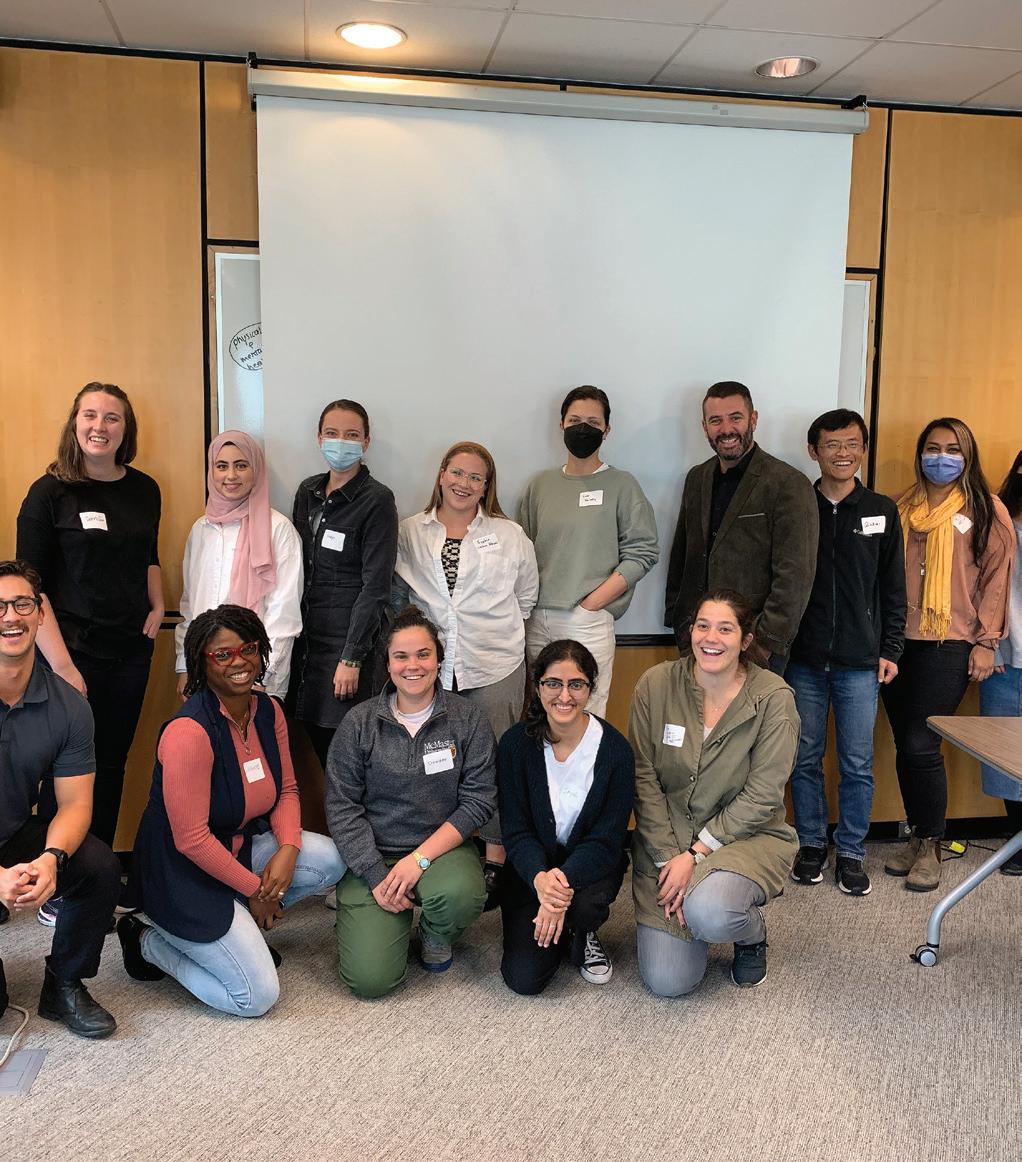
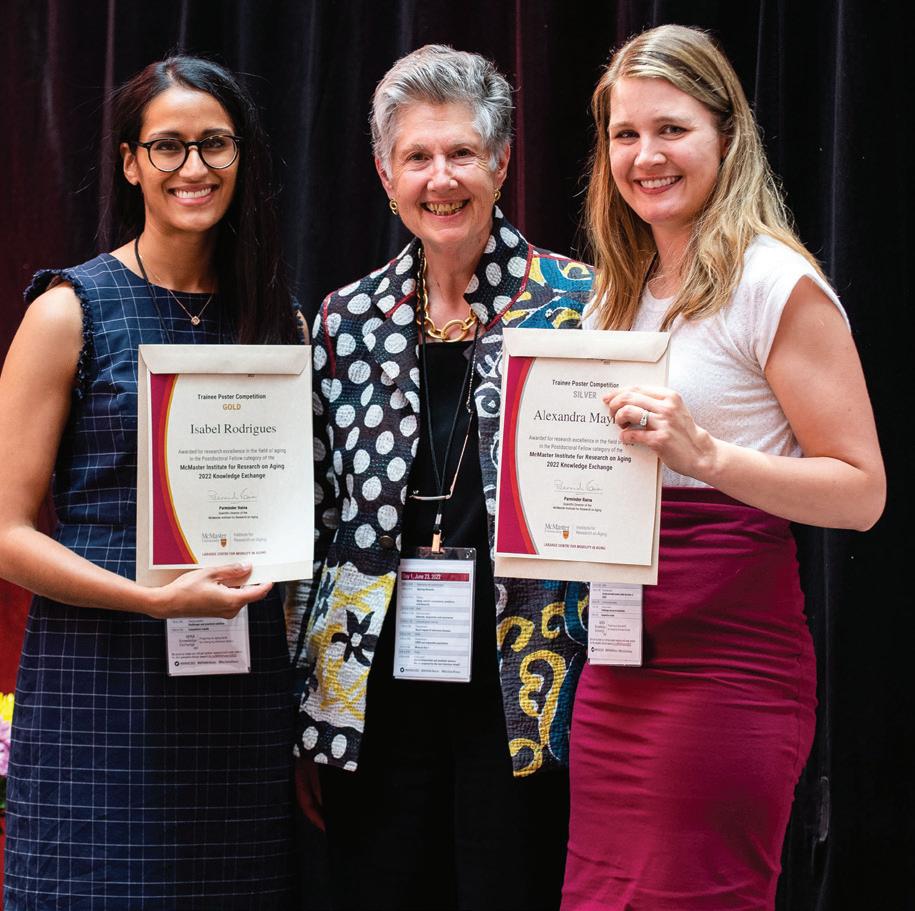
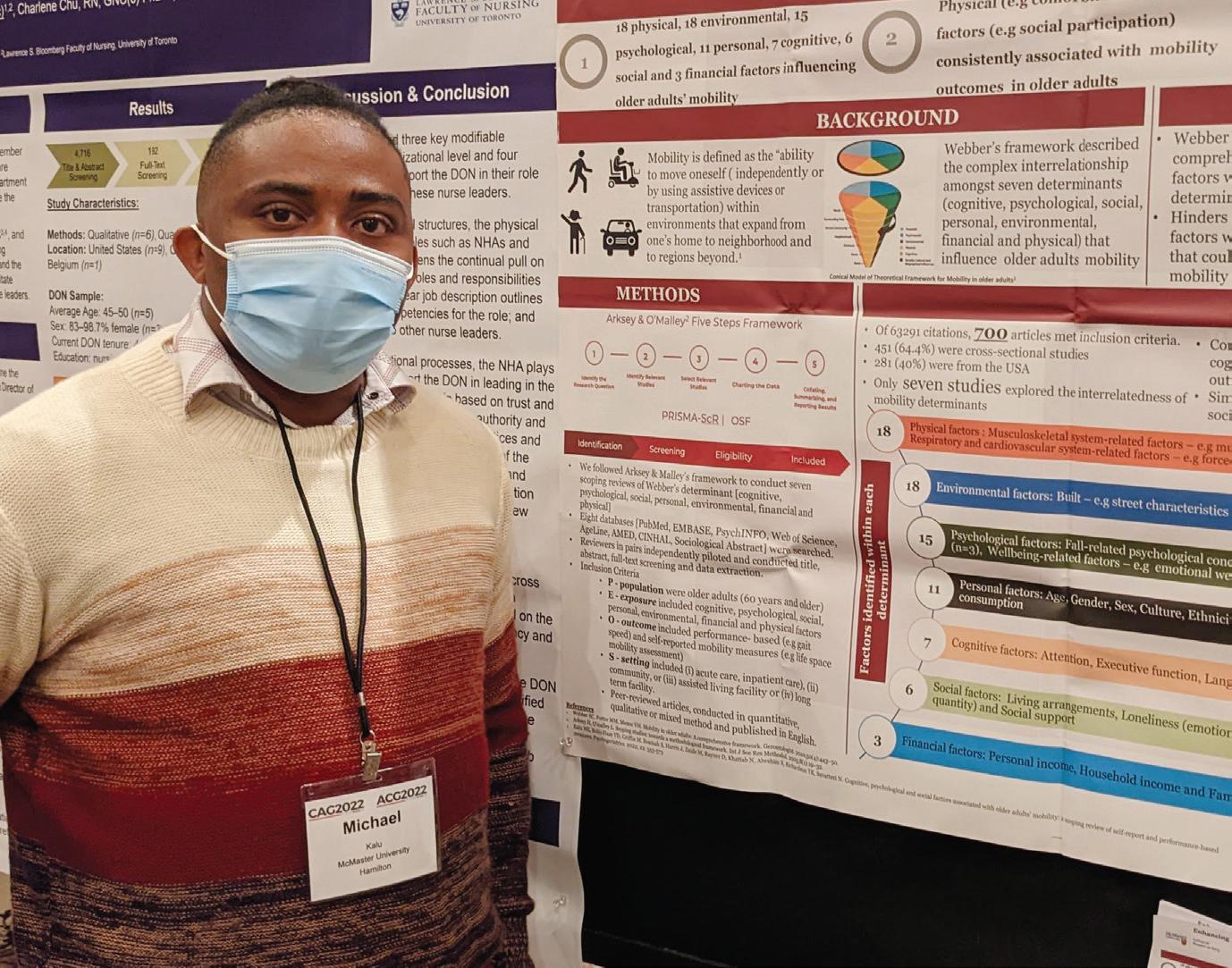
|
Developing a real-world framework for remote patient monitoring technologies that promote optimal aging
TRAINEE | Chi-Ling Joanna Sinn FHS
SUPERVISOR | Andrew Costa FHS
MENTORS | Carolyn Gosse St. Joseph’s Health System, Jean-Eric Tarride SOSCI and Nicole Wagner BUS
HIGHLIGHT | As Research Fellow and Evaluation Coach with the Centre for Integrated Care, ChiLing Joanna Sinn developed a workshop series that walks teams through how to develop a program logic model as well as performance indicators (used for monitoring and evaluation) based on the model. Sinn delivered this workshop to two integrated care teams in 2022 and presented work to Elizabeth Buller, President & CEO of St. Joseph’s Health System.
Relationship between biomarkers and musculoskeletal pain and falls in older adults: A cross-sectional analysis of the Canadian Longitudinal Study on Aging data.
TRAINEE | Diego Roger-Silva FHS SUPERVISOR | Luciana Macedo FHS
TRAINEE | Jessica Breznik FHS
SUPERVISOR | Dawn Bowdish FHS
MENTORS | Arthur Sweetman SOSCI and Paul McNicholas SCI
MENTORS | Stuart Phillips SCI and Manaf Zargoush BUS
HIGHLIGHT | This project informed public health policy during the pandemic, contributing to evidence-based decisions of the province of Ontario to prioritize providing COVID-19 mRNA vaccines to older adults, prompting offering of third doses in Fall 2021, fourth doses with the emergence of the Omicron (BA.1) variant and fifth doses (bivalent vaccines) to maintain protective immunity against SARS-CoV-2. Project data will continue to answer fundamental questions about the aging immune system and vaccine efficacy in older adults and will inform practices to prevent future outbreaks of COVID-19 and other infectious diseases.
TRAINEE | Mina Nouredanesh FHS SUPERVISOR | Marla Beauchamp FHS
Ageism in the time of technological innovation: Understanding older people’s digital landscapes
TRAINEE | Stephanie Hatzifilalithis SOSCI
SUPERVISOR | Nicole Dalmer SOSCI
MENTORS | Milena Head BUS and Paula Gardner HUM
MENTORS | Parminder Raina FHS, Manaf Zargoush BUS and Paul McNicholas SCI
HIGHLIGHT | Stephanie Hatzifilalithis was awarded the Best Poster Award at the 2022 AGE-WELL Annual Conference in Regina, Saskatchewan. Hatzifilalithis also spoke with national media on multiple occasions about the importance of involving older adults in the design of new technologies.
2020 | MIRA Postdoctoral Fellowship
Enhancing the quality of life for older adults with end-stage knee osteoarthritis through patient phenotyping to tailor the clinical management
TRAINEE | Fatemeh Jazinizadeh FHS SUPERVISOR | Janie Wilson FHS
2019 | MIRA Postdoctoral Fellowship
Promoting optimal aging through equitable access to specialized geriatric services in Ontario
TRAINEE | Sophie Hogeveen FHS SUPERVISOR | Andrew Costa FHS
2018 | MIRA Postdoctoral Fellowship
Project RespIR: Remote respiration and breathing patterns assessment using infrared imaging
TRAINEE | Wael Brahim ENG SUPERVISOR | Lotfi Belkhir ENG
2021 | MIRA PhD Scholarship
Promoting optimal aging through equitable access to ‘care of the elderly’ family physicians
TRAINEE | Rebecca Correia FHS SUPERVISOR | Andrew Costa FHS
MENTOR | Arthur Sweetman SOSCI
2021 | MIRA Master’s Scholarship
Understanding how aging affects blood pressure through oxidative stress
HIGHLIGHT | Rebecca Correia was awarded a CIHR Canada Graduate Scholarships Doctoral Award in May 2022.
TRAINEE | Mariia Khamina FHS SUPERVISOR | Giuseppe Melacini SCI MENTOR | Jonathan Schertzer FHS
2021 | LCMA Postdoctoral Fellowship
The iCare study: an integrated collection of education modules on fall and fracture prevention for healthcare providers
TRAINEE | Isabel Rodrigues FHS SUPERVISOR | Alex Papaioannou FHS MENTOR | Manaf Zargoush BUS and Rong Zheng ENG
2021 | LCMA PhD Scholarship
A transdisciplinary approach to older adults care in a Canadian primary healthcare setting: exploring the possibility in an interprofessional education program.
TRAINEE | Augustine Okoh FHS SUPERVISOR | Lawrence Grierson FHS MENTOR | Ellen Badone SOSCI
Assessing validity and sensitivity of remotely collected wearable sensor data in patients
TRAINEE | Matthew Ruder SCI
SUPERVISOR | Dylan Kobsar SCI
MENTORS | Rong Zheng ENG
Indigenous inclusion in the Canadian therapeutic platform trial for multi-domain interventions to prevent dementia (CAN Thumbs Up)
TRAINEE | Joyla Furlano FHS
SUPERVISOR | Jennifer Walker FHS
HIGHLIGHT | From this work, Matthew Ruder received a $52,500 Training Graduate PhD Salary Award from Arthritis Society of Canada for his dissertation research. Ruder attributes LCMA funding for jumpstarting his PhD research.
HIGHLIGHT | Joyla Furlano went on to a faculty position at OCADU.
Can dance reduce falls-risk in older adults with mild cognitive impairment?
TRAINEE | Patricia Hewston FHS
SUPERVISOR | Alexandra Papaioannou FHS
MENTORS | Amanda Grenier SOSCI and Steven Bray SCI
Designing a real-time cybercrime alert system for older adults: A neurophysiological solution during COVID-19
TRAINEE | Xuecong Lu BUS
SUPERVISOR | Milena Head BUS MENTORS | Brenda Vrkljan FHS and Ridha Khedri ENG
Understanding older adults’ active travel
TRAINEE | Léa Ravensbergen SCI
SUPERVISOR | Bruce Newbold SCI MENTORS | Rebecca Ganann FHS and Christina Sinding SOSCI
HIGHLIGHT | Patricia Hewston leveraged work with GERAS DANCE into a series of new grants. Hewston is now Assistant Clinical Professor (Adjunct), Rehabilitation Science, Faculty of Health Sciences
HIGHLIGHT | Xuecong Lu was part of the team, led by Milena Head, that received a Social Science and Humanities Research Council of Canada (SSHRC) Insight Research Grant over $200,00 for the project “Helping older adults to better cope with information technology threats”
HIGHLIGHT | Following a postdoctoral position at Oxford, 2019 MIRA Postdoctoral Fellow Léa Ravensbergen accepted an offer to return to McMaster as an Associate Professor in the School of Earth, Environment and Society.
In October 2022, one of MIRA’s long-term aspirations was achieved when McMaster announced that the new Lincoln Alexander Hall, an undergraduate residence on Main Street West in Hamilton, would include a space designed to encourage students and older adults from the community to socialize and learn together. This intergenerational hub will be hosted by MIRA. The design of this space has been informed by Brenda Vrkljan’s award-winning research on designing intergenerational spaces as well as co-design consultations with both older adults and students to ensure the space meets the needs and interests of both groups.

This space will serve as a natural home for MIRA’s ongoing intergenerational programming. After a pilot year in 2019, MIRA moved its intergenerational activities online in 2020 and operated them virtually through 2022. Supported by practicum students from the department of health, aging and society, this virtual programming engaged 25 older adults and 60 students from inception. End-of-term surveys indicated that this programming supported both older adults and students in building a sense of community, and both groups felt it had a positive impact on their moods. Student participants indicated it positively impacted their perceptions of older adults and healthy aging in communities.
Beginning in fall 2022, continued support from the New Horizons for Seniors Program allowed staff to offer more options for in-person programming, while continuing to offer a virtual option as well. This hybrid programming has allowed MIRA to engage new participants who are excited to connect in-person, while offering an accessible option that allows both older adults and students to continue to join remotely. In the coming year, MIRA looks forward to partnering with new departments and organizations both on-campus and in the community to extend this program’s reach in its new hybrid format.


The intersectionality, Aging and Mobility Human Conversation eXchange, (iAM Human), developed by Brenda Vrkljan, is an educational initiative aimed at growing awareness about aging, intersectionality and cultural humility. The platform brings together trainees, researchers and community members from different sectors, backgrounds and lived experiences around a shared vision: creating a safe space for intergenerational dialogue and training that advances knowledge, skills and understanding of equity, diversity, inclusion and Indigenous reconciliation with an aging lens.

In 2022, the iAM Human project team developed the platform and its content, including completing a scoping review, creating an online learning portal, developing learning materials, establishing and meeting with advisory committees, and recruiting community partners from across the region. In keeping with design-thinking principles, the project has sought feedback throughout the development process from both learners and older adults.
The platform launches in 2023, enrolling older adults and trainees in the training and conversation exchange. This launch will include an evaluation of both the iAM platform and perceptions of aging and ageism. The team is also developing a sustainability plan to be able to offer this learning experience and expand its reach in the long-term.

The Caregiving Essentials program, developed in 2018 in partnership with MIRA, continues to be offered by McMaster Continuing Education (MCE) to caregivers, health-care professionals and others interested in caregiving. Beginning in 2022, individuals who successfully complete Caregiving Essentials are eligible for a digital micro credential issued by MCE.
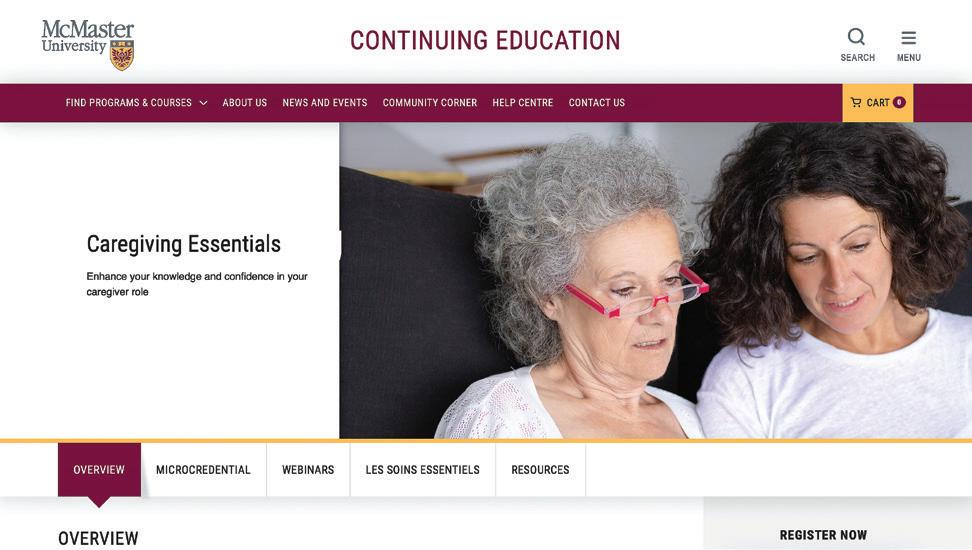
This open-access, no-cost online program is now complemented by a 24-episode webinar series featuring caregiving experts hosted by Donna Thompson who is a caregiver, author and educator. In Fall 2022, guests included Tanya Yarkoni, founder of a program called Integrative Caregiving, and Brian Goldman, emergency physician, author and host of CBC Radio’s White Coat, Black Art.
In 2019, Caregiving Essentials was recognized with the Non-credit Programming (under 48 hours) Award by the Canadian Association for University Continuing Education.
In 2021, MCE received provincial funding through the Virtual Learning Strategy competition to create a French-language version of Caregiving Essentials. Collaborating with Collège Boréal and Laurentian University, MCE launched les soins essentiels in spring 2022. Les soins essentiels is supported by the Canadian Centre for Caregiving Excellence and l’Appui, a caregiving support organization for French-speaking caregivers living in Quebec.
Since 2018, 2306 people have taken Caregiving Essentials. 39 people have taken Les soins essentials since it launched.

In 2021, based on the feedback of MIRA’s five-year review, its former End User Stakeholder Committee was separated into a Stakeholder Committee and a Community Partner Network, consisting of local partners working in service-facing sectors with direct day-to-day engagement with older adults. In keeping with its terms for the committee, MIRA has met twice with the Stakeholder Committee, first to identify strategic partnership opportunities in its existing research projects and later in 2022 as part of the Institute’s strategic planning process. MIRA maintains regular engagement with its Community Partner Network and looks forward to including representatives from the Network in its strategic planning process in 2023. The Community Partner Network has provided invaluable insights during the development of a new digital divide major program of research, sharing insights on the lived experience of older adults and the need for equitable solutions to bridge the divide.
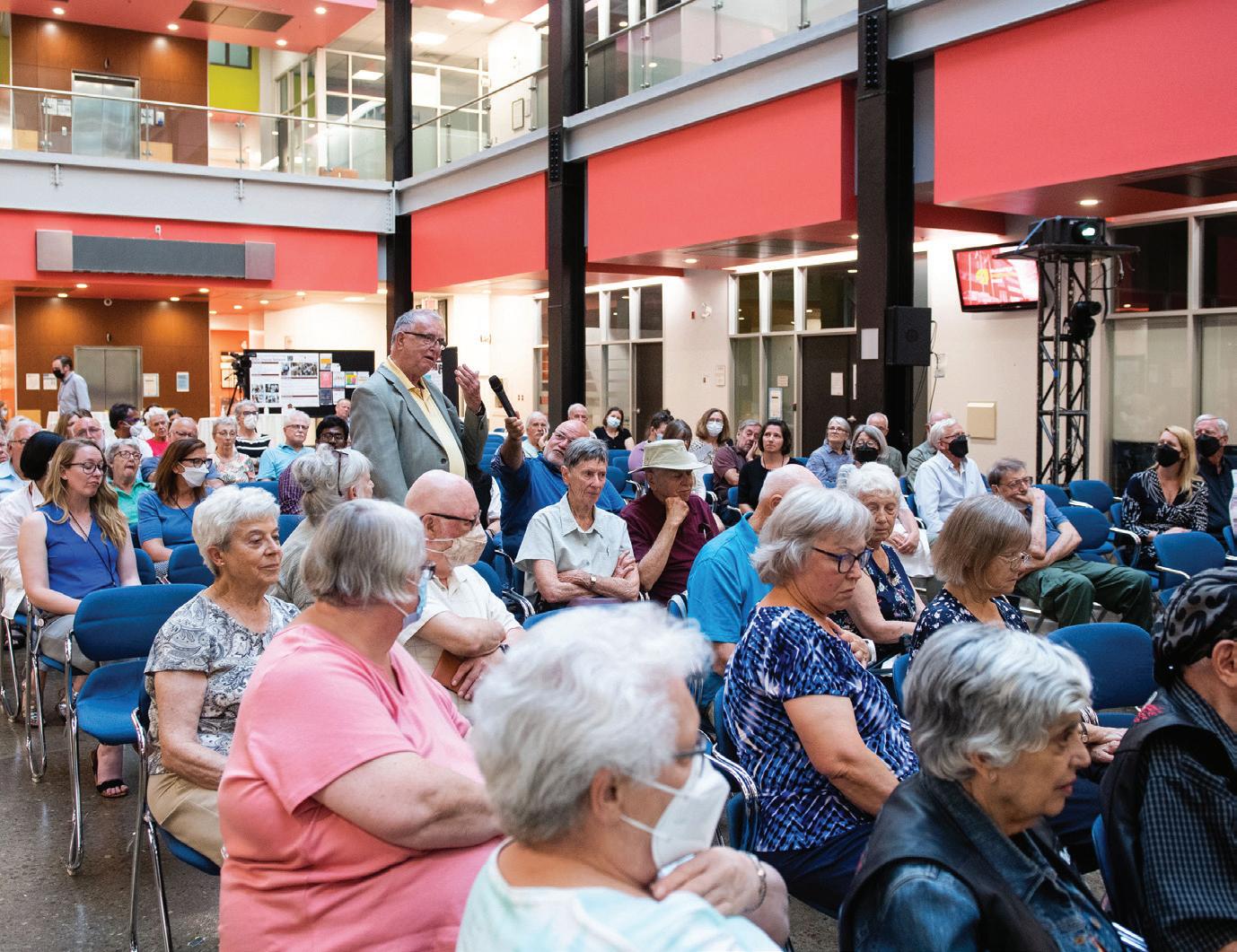

MIRA hosted four virtual community consultations to support the development of new research programs and proposals this year, focusing on intergenerational aspects of aging, bridging the digital divide, and the overlap of aging and infections disease. Sessions were attended by 16 community members and stakeholders on average. Hosted over Zoom, these sessions incorporated the use of the online collaboration tools Miro and Mentimeter to give participants the ability to share insights and feedback effectively. The input and ideas generated by these sessions are critical to supporting MIRA researchers with enduser feedback from inception through implementation.
MIRA continued to build upon its existing network of partnerships in 2022. MIRA staff and researchers participated in the inaugural PIVOT Symposium, a day-long event exploring how communities can be transformed by art, technology and creativity. This was a valuable opportunity to highlight our ongoing work on inclusive design and technology to a breadth of leaders in the Hamilton area. The symposium was found to align deeply with research on bridging the digital divide. MIRA also engaged with representatives from the Ontario government, following the 2022 election, to update government staff on MIRA’s ongoing work supporting the province’s aging population and to identify areas of shared interest for future collaboration. Working with Dixon Hall, MIRA looks forward to expanding its community partners in the Toronto-area in the coming year.
In 2022, MIRA entered into a partnership with Newcastle University and the United Kingdom’s National Innovation Centre for Ageing (NICA) to launch a Canadian chapter of their successful Voice digital community engagement platform. Voice brings together older adults, caregivers and members of the public who contribute their ideas and lived experiences to help identify priorities for research and unmet needs by participating in research and research design opportunities. Like MIRA, NICA and Voice support the idea that community members should be involved in all stages of the research cycle and that their knowledge and experience bring great value to research.
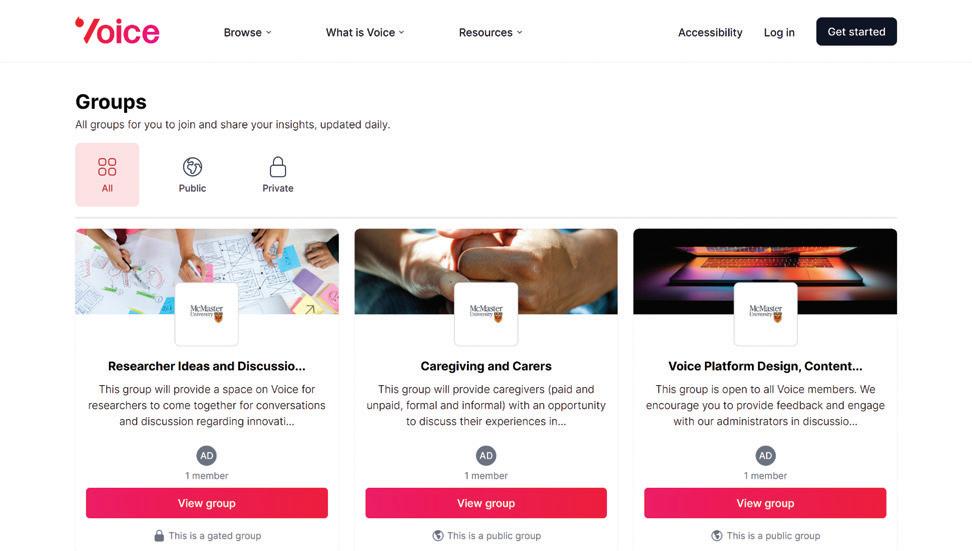

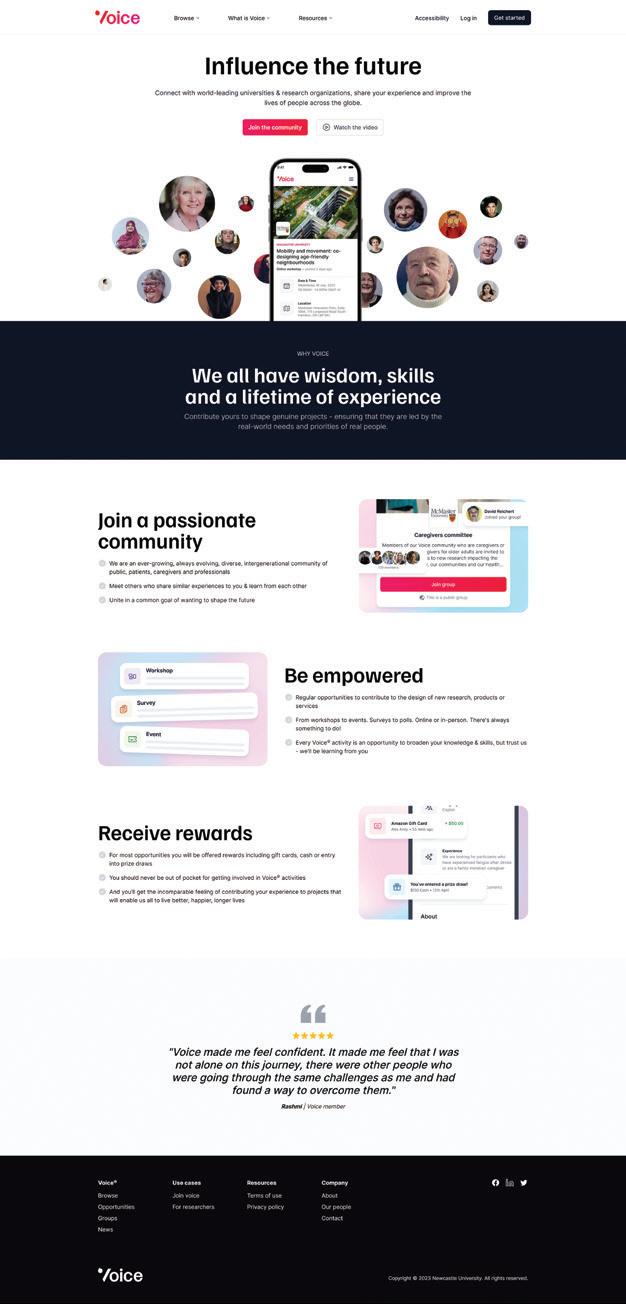
Voice is a tool for MIRA researchers to rapidly receive feedback during the development of big research questions both at early stages — such as establishing how people feel on a topic, or what their priorities are for a certain subject — and throughout the life of a project. MIRA believes that the platform will help encourage a culture of research participation with older adults who may not have previously engaged with the Institute’s work.
To support the 2023 launch of Voice, MIRA staff laid important groundwork in 2022 by ensuring the platform aligns with Canadian and McMaster privacy and legal standards and have initiated an application for the platform’s use as a research recruitment tool that was jointly reviewed by both McMaster research ethics boards. MIRA is joining Voice as the platform undergoes a substantial redesign to its look and functionality. MIRA staff have been able to participate in and support the testing of this redesign, and they are well prepared to begin supporting researcher and public users in the first half of 2023. MIRA looks forward to launching the platform with an initial design-thinkingcentred event that encourages researchers to consider creative ways to engage with their communities, followed by a public launch in spring 2023.
As a research institution, MIRA focuses on supporting cutting-edge projects that advance the scope of understanding and implementation in aging research. MIRA is committed to bringing the results of researchers’ efforts to the older adult community — through public events, conferences, talks, activities, workshops and more. In 2022, after a pandemic hiatus, MIRA was happy to return to engaging the aging community in a variety of safe, informative and fun settings.
In May, community members were invited to Inclusive Spaces for Aging Well, a public talk celebrating the Hamilton stop of the Queen’s Baton Relay in advance of the 2022 Commonwealth Games. Featuring eight speakers from the University of Birmingham, McMaster University and the community, over 150 attendees listened to short, dynamic presentations focused on how to create spaces that enable everyone to be active and participate in community as they age. MIRA’s first in-person event since the pandemic began, this event helped reintroduce the Institute as a source for accessible, engaging and evidence-based aging information, while strengthening relationships with partner institutions, community groups and honouring vital Indigenous perspectives.
As part of the 2022 MIRA Knowledge Exchange in June, MIRA invited the public to learn more about what made the pandemic especially challenging for aging populations and how to prepare for future threats. Featuring celebrated Globe and Mail health columnist André Picard and other experts, the event engaged over 300 members of the community in discussion and presentations about the various social, economic and physical ways the pandemic affected older adults, caregivers and people from marginalized communities.
The MIRA | Dixon Hall Centre hosted a public event in Toronto where community members enjoyed an introduction to MIRA, a community fair and a presentation and demonstration on Nordic pole walking. This event, attended by over 75 older adults from the area, served as the first public-facing union of Dixon Hall’s expertise in providing comprehensive community-based client care and MIRA’s excellence in creating innovative research programs centered around aging and older adults.
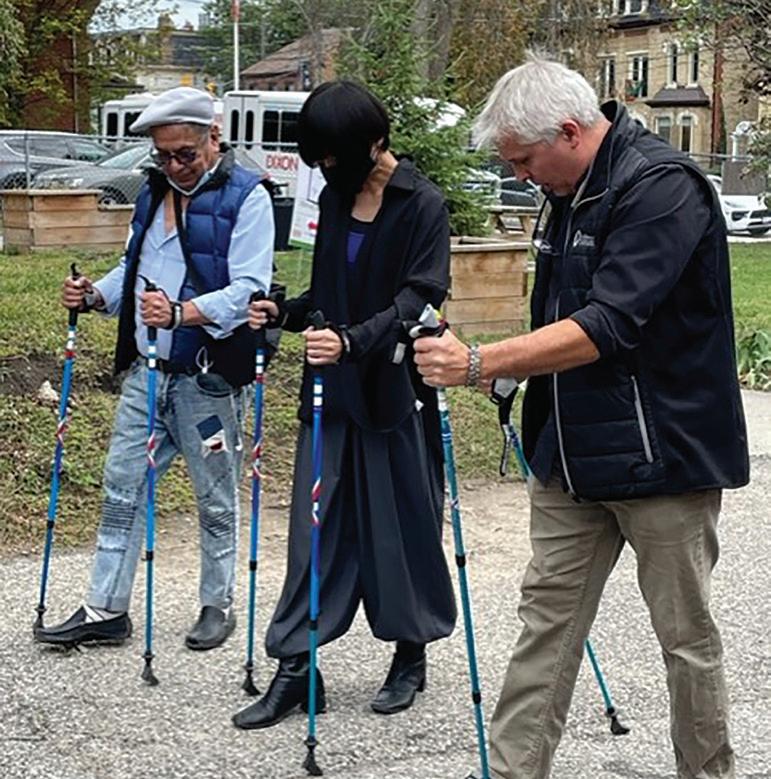
MIRA’s One Topic, Two Disciplines seminar series explores pressing challenges in aging research and interdisciplinary approaches to solving them. In a spring and fall session, the well-attended online series brought together researchers with different expertise on a single topic in aging.
In 2022, MIRA also attended events sponsored by community partners such as the City of Hamilton’s Seniors Kick-Off and the launch of the Faces of Dementia campaign, a public awareness initiative of the Empowering Dementia-Friendly Communities, Haldimand, and Hamilton project led by the Hamilton Council on Aging. This return to public events after the pandemic has provided MIRA with an opportunity to connect to new individuals and partner organizations, increasing its visibility in the city.
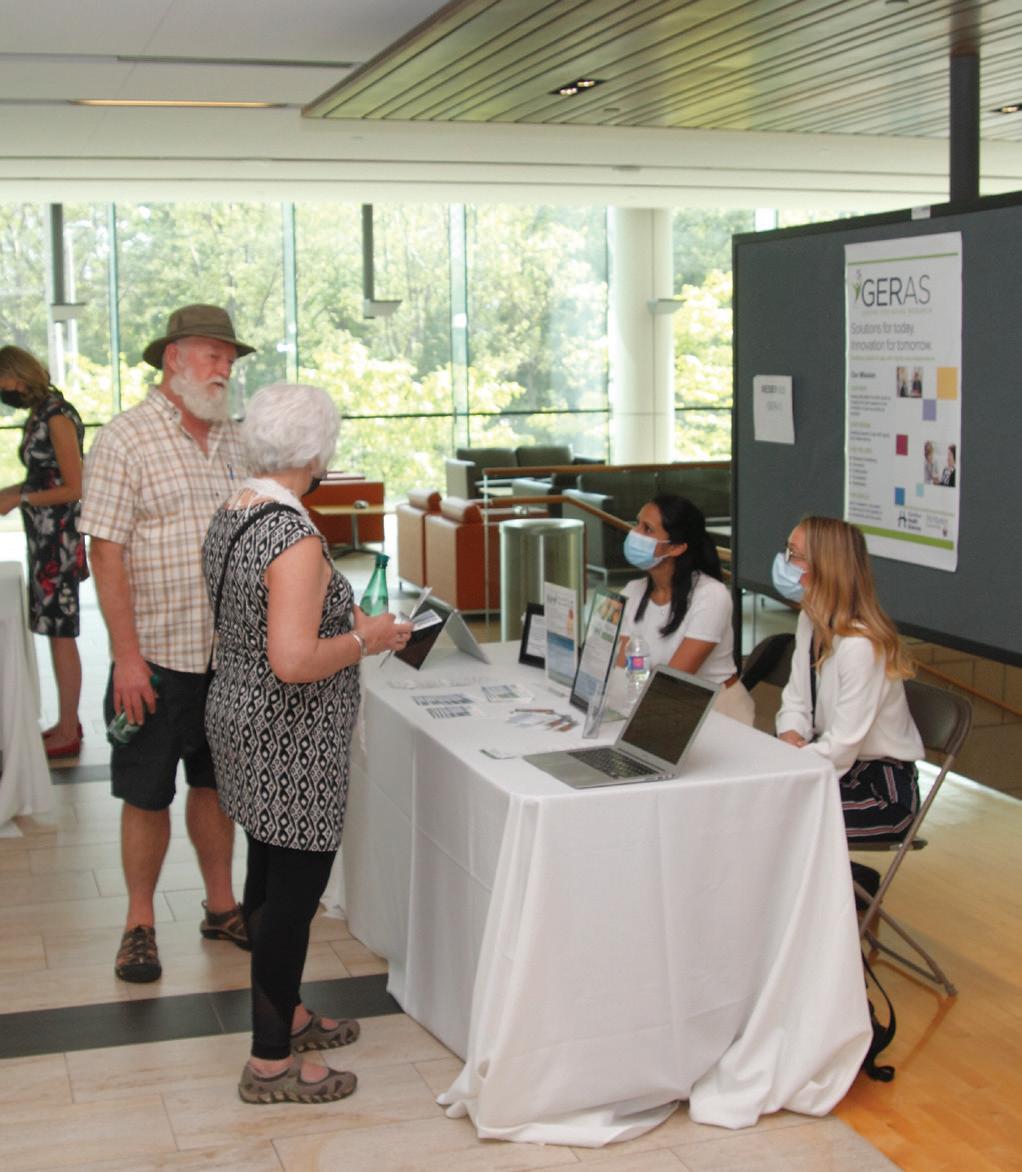
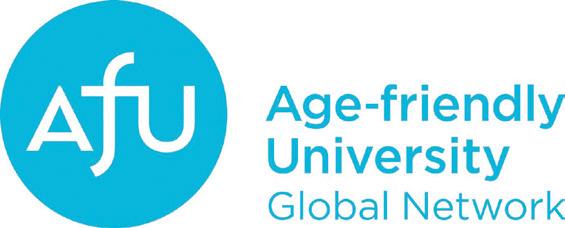
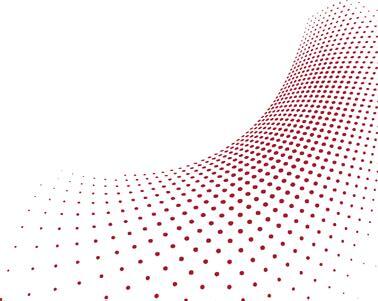

In 2017, McMaster University joined the international Age-Friendly University network, a global body of higher education institutions committed to being more accessible to older adults. In 2018, MIRA undertook several studies to understand the alignment of McMaster University’s existing facilities and programs with the 10 principles of an Age-friendly University (AFU). Through this research, MIRA identified three areas of growth: communications and outreach; accessibility and inclusion and programming and engagement.
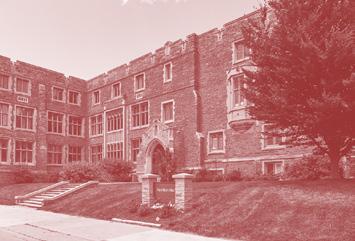
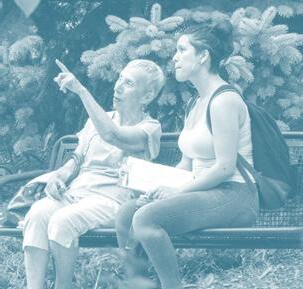

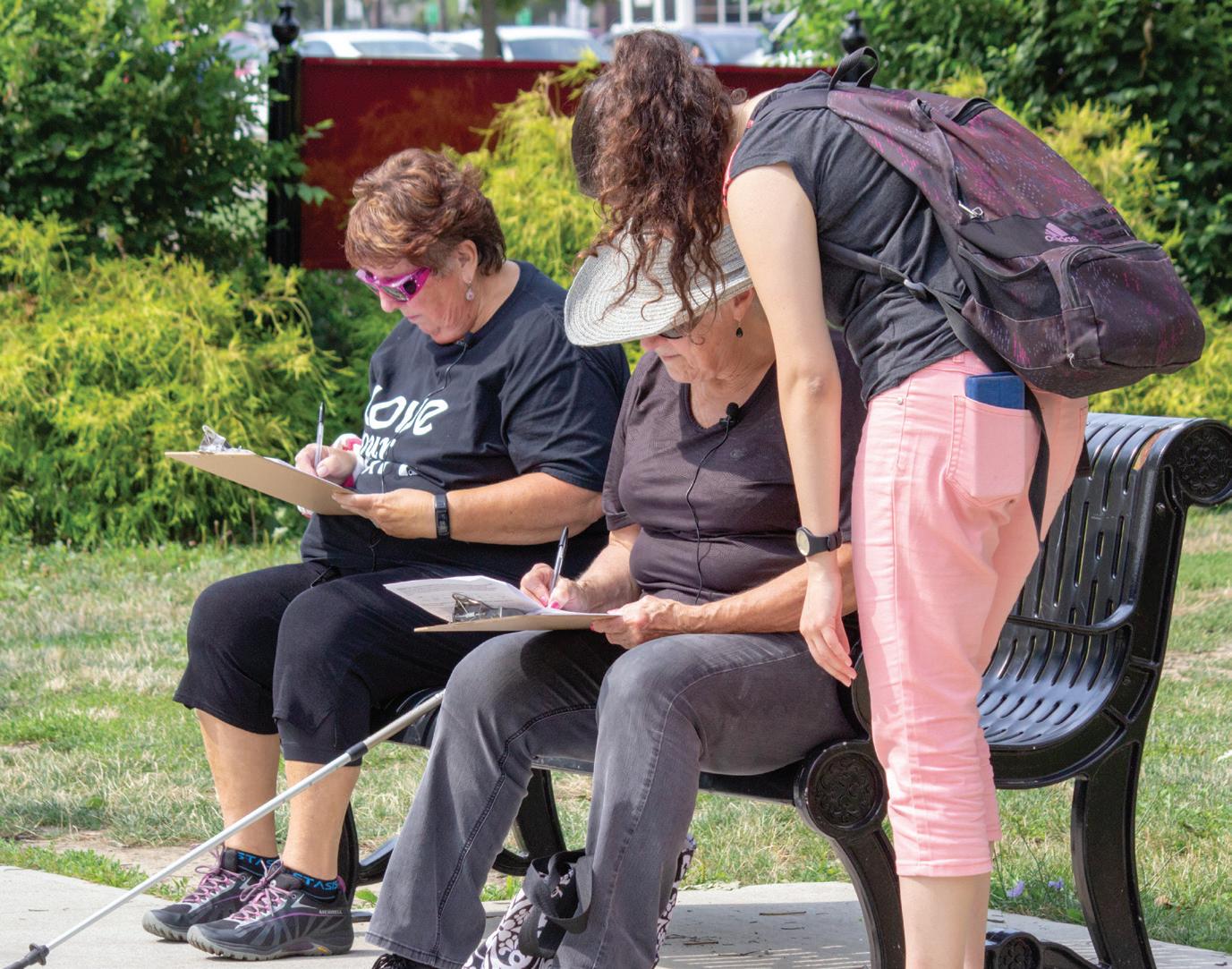

In order to support the University to continue to work towards improvements in its alignment with the AFU principles, MIRA spearheaded the creation of the AFU committee, a steering committee comprised of 40 members from 30 different units at McMaster, including student, staff, alumni and community service units as well as aging platforms across McMaster.
In 2022, the AFU committee adopted a community-of-practice model, with members sharing their units’ work and experiences as they align with the principles of an AFU. Since this shift, the committee has heard presentations from Hamilton Council on Aging’s Empowering Dementia-Friendly Communities, Haldimand, and Hamilton project and Human Resource Services. This new model has been successful in encouraging idea sharing, increased awareness of the work of different units, creating spaces for dialogue among researchers and staff passionate about this work, and resulted in new collaboration opportunities.
For the Ages: How McMaster University is becoming Age-Friendly
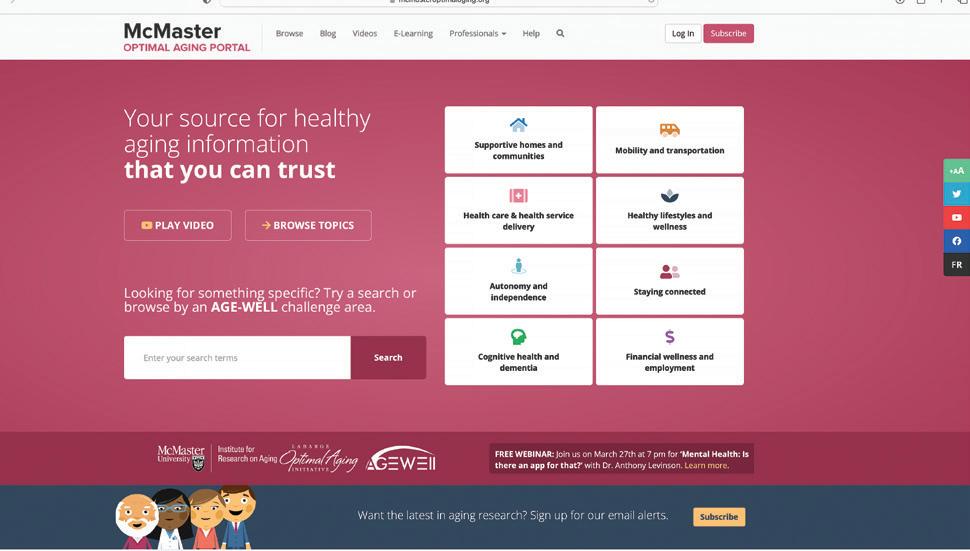

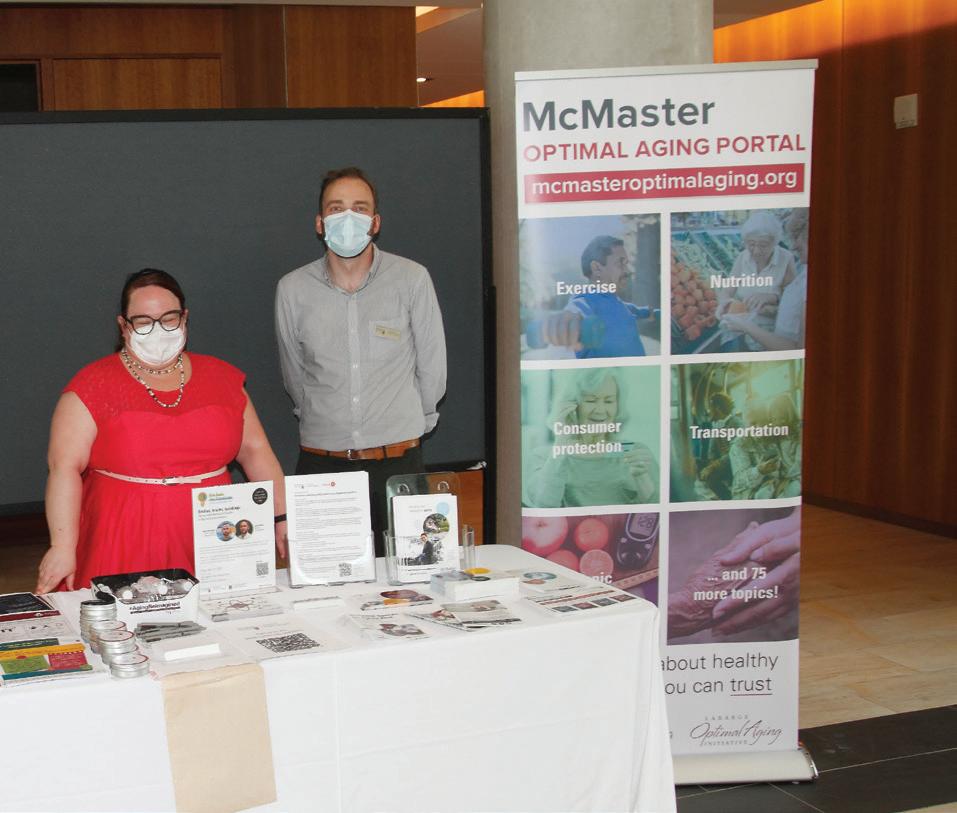
The McMaster Optimal Aging Portal continued to grow as a key resource to support older adults, caregivers, clinicians, public health professionals, social system professionals, and policymakers from around the world who are looking for a trusted source of credible, evidence-based information about the health and social aspects of aging. This year, the Portal continued to provide resources on a wide range of topics (including the COVID-19 pandemic and response) while expanding the production of enhanced multimedia content in the area of mobility. This year saw a more conservative Portal operations budget than 2021, but still, the portal used its production and marketing dollars judiciously and was able to achieve significantly increased engagement with new and existing users.
In 2022 the steady growth in portal users was maintained, with close to 4 million total users since launch, including from an increasingly global userbase.
In 2022, the Portal published an additional e-learning module and 16 videos with McMaster experts discussing a wide range of topics related to healthy aging and mobility. User engagement and satisfaction with these new forms of content have been very high, as evidenced by survey responses and online quizzes and downloads of custom resources. Total E-Learning Views increased to 43,044, up from 32,972 in the previous year.
Efforts toward securing the long-term sustainability of the Portal continued in 2022. In addition to the generous funding provided by Suzanne Labarge and partners, the Office of the Vice-President, Research and the MIRA | Dixon Hall Centre were confirmed to help support the Portal operations in 2023 and 2024.
The Optimal Aging Portal’s leadership team are continuing their efforts to ensure sustainable, long-term funding and ‘market’ growth, while implementing innovations to make the Portal more enticing to a broader audience — all while ensuring that the Portal content and website remain independent and non-biased.
Held June 23 and 24 at McMaster Innovation Park (MIP), the MIRA Knowledge Exchange brought together McMaster’s aging and infectious disease research communities, and international experts, around the topic of “preparing an aging world for emerging infectious threats.”
Hosted by MIRA, in partnership with Canada’s Global Nexus for Pandemic and Biological Threats, the Knowledge Exchange saw experts from all six McMaster Faculties discuss immunity, vaccination, mental health, mobility, social isolation and infectious disease as they apply to aging populations.

MIRA’s yearly Knowledge Exchange, gave aging researchers the opportunity to connect, discuss ideas and form new collaborations. Partnering with Nexus allowed MIRA to add perspectives from infectious disease research; strengthening and advancing the holistic nature of aging research at McMaster.
The event featured keynote talks from Jonathan Bean of Harvard Medical School, Marla Beauchamp of McMaster and James Kirkland, President of the American Federation for Aging Research and Professor at the Mayo Clinic. Bean and Beauchamp spoke about rehabilitation in aging and Kirkland presented on senescence, senolytics and immunity.
Presentations and cross-faculty panels explored topics including immunity, diagnostics, vaccination, social impacts of infectious disease and how COVID affects vulnerable populations, including an appearance via Zoom from Dalhousie frailty expert Ken Rockwood. Researchers from the fields of health sciences, medicine, rehabilitation, business, economics, engineering physics, humanities, nursing and philosophy shared perspectives in the sun-drenched Atrium of MIP.
A large interdisciplinary panel discussed the many ways that health systems have been strained under the pressure of the pandemic — analyzing individual, social and system-level vulnerabilities impacting aging communities.
The event also featured thirteen exhibitors and a trainee poster competition highlighting MIRA-funded research projects and allowed close to 40 presenters (some virtually) to showcase the contributions of students and postdoctoral fellows to interdisciplinary research in the field of aging.
A public talk, which drew over one hundred community members in-person and another 200 online, capped the first evening. Featuring celebrated Globe and

Mail health columnist André Picard, director of the Center for Peace Studies Chandrima Chakraborty and infectious disease physician Zain Chagla, the talk approached the lessons of the pandemic from a clinical, community and social perspective followed by a questionand-answer period. The event effectively engaged the public in discussing why and how marginalized aging communities were disproportionately affected by the pandemic.
Artists Shannon Loomer and Vesna Asanovic visually narrated the symposium, creating large illustrations in real time that highlighted the connected and complex topics of aging and infectious disease in an accessible and visually appealing way.

Suzanne Labarge, former Chancellor of McMaster and a long-time supporter of aging and mobility research at the university ended the symposium by presenting awards to the winners of MIRA’s trainee poster competition:




Postdoctoral Fellow
Gold: Isabel Rodrigues
Silver: Alexandra Mayhew
PhD
Gold: Karla Martinez Pomier
Silver: Kevin Moncion, Jennifer Williams
Master’s
Gold: Sophia Werden Abrams
Silver: Jayati Khattar
Undergraduate
Gold: Janani Sridev
Silver: Amraj Dhillon, Farzad Haji Boloori
People’s Choice (virtual posters)
Yuva Venkata Raghava Neelapala
In 2022 MIRA continued to develop projects and programs in collaboration with existing and new partners. In 2022, 10 new partnerships were developed with organizations while existing partnerships progressed.

Within McMaster University, MIRA developed new collaborations with smart Mobility for Aging Population (sMAP) to support highly qualified personnel education and training by co-funding of graduate students. MIRA partnered with Global Nexus for Pandemics and Biological Treats to co-fund a catalyst grant in the biology of aging and a Canada First Research Excellence Fund (CFREF) application for the Readying Aging Populations for Pandemics and Infectious Dangers (RAPPID). MIRA also engaged the McMaster Indigenous Research Institute (MIRI) to support successful IndigiNerds program students who propose to conduct aging research. MIRA continued its successful partnership with the Gilbrea Centre for Studies in Aging and director Anthea Innes to support hiring a postdoctoral fellow and collaborate on intergenerational programming. MIRA partnered with the School of Rehabilitation Science to support the next Hooker Visiting Professor, Cathie Sherrington from Australia in May 2023.

MIRA continued its partnerships and collaboration with the Office of International Affairs to support international visitors to McMaster and the Institute for Pain Research and Care to co-fund a catalyst grant. MIRA continues to work closely with The McMaster Division of e-learning Innovations (DELI), McMaster Advancement and Dixon Hall to support the Optimal Aging Portal and its long-term sustainability. Through MIRA’s Age-Friendly University Committee MIRA connects and collaborates with a broad range of membership across McMaster University such as McMaster University service units for students, staff, alumni, major academic units, and aging platforms.
MIRA worked with several new external partners on a variety of activities. MIRA established its partnership with Birmingham University while hosting the Queen Baton Relay in advance of

Commonwealth Games in 2022 and holding a public program featuring a diverse, eight-member public panel on Inclusive Spaces for Aging Well. MIRA has joined Birmingham University’s ATTAIN research network enabling collaborations between researchers from across the UK and beyond. MIRA established collaborations with Lund University in May of 2022 through McMaster University’s effort to establish a joint PhD program with Lund. MIRA hosted the Lund delegation and now has representation from its key aging researcher on MIRA’s International Scientific Advisory Committee. MIRA continued its work with the National Health Sciences Alliance to drive knowledge exchange and innovation in healthy aging; the Institute for Technology Carlow to support MIRA’s work on co-design and design thinking; Leeds University to engage with MIRA’s next major program of research investigating complex interventions for frailty and aging well; Newcastle University and the UK National Innovation Centre for Ageing to launch the Canadian chapter of Voice and to explore the development of an Aging Innovation Centre in Hamilton; and AGE-WELL and the Canadian Frailty Network in co-funding scholarships and research programs.
MIRA has been working with the World Health Organization on systematic reviews to measure mobility in community dwelling older adults and the development of a proposed WHO-MIRA framework for measuring the facets of mobility in later life. MIRA is also applying to be a WHO collaborating centre on aging.
This year, MIRA attracted the attention from several policy makers and government officials. Following the pandemic MIRA re-engaged with the Ontario government, specifically with the Deputy Minister for both Ministries of Long-Term Care and for Seniors and Accessibility. A meeting was held with Nancy Matthews and her office to explore opportunities for collaborations. This year, MIRA was visited by the Ontario Minister for Long-term Care, Paul Calandra and the Federal Minister Filomena Tassi, responsible for Federal Economic Development Agency for Southern Ontario to learn about how MIRA could inform future policy development to support older adults.
This year, MIRA continued the successful One Topic, Two Disciplines webinar series. At these sessions, MIRA brings together two speakers to discuss their work and emerging ideas in a topic area.
In a slight change from the usual format, the July One Topic, Two Disciplines webinar brought together not only the expertise of two researchers, but the valuable experience of MIRA’s community partner, Dixon Hall. Focusing on the topic of precarity and aging, the addition of a knowledgeable community voice gave audience members a deeper understanding of the issue. Speakers for the event were Michelle Wyndham-West (OCADU; and (adjunct faculty member in the Department of Health Aging & Society at McMaster), Courtney Kennedy (Department of Medicine, and associate director of the GERAS Centre within Hamilton Health Sciences) and David Reycraft (Director of Housing Services at Dixon Hall).

The September One Topic, Two Disciplines, on supporting older women in ways that work, featured Alison Shea (Department of Obstetrics & Gynecology) and Saara Greene (Department of Social Work). Shea and Greene discussed the importance of incorporating the lived experiences of women into research and knowledge mobilization and the relevance of that practice to reaching a wide range of stakeholders including health and social care professionals, allied service providers that work with older women and the diverse community of women that they serve.
At the 2022 Annual Scientific and Educational Meeting of the Canadian Association on Gerontology (CAG 2022), MIRA members, staff and trainees were part of research teams delivering 30 presentations (with 13 presented by MIRA) and 15 posters (nine presented by MIRA) — a notable number of the total presenter and posters. MIRA hosted a booth along with the Canadian Longitudinal Study on Aging at the event and connected with researchers and trainees working in the field of aging research about many of the exciting projects happening at McMaster. The Gilbrea Centre for Studies in Aging also held a booth at CAG 2022, demonstrating the abundance of aging research at McMaster.
The Labarge Centre for Mobility in Aging had yet another successful year supporting bold and motivated researchers and trainees leading work in mobility and aging.


Partnering with the World Health Organization (WHO), MIRA is translating years of extensive and successful research and knowledge mobilization in mobility into an ambitious project creating a framework for measuring mobility for older adults living in the community. This work began in October 2021 and includes preparing multiple systematic reviews on the psychometric properties of life space and patient-reported mobility. MIRA is also in discussion with the WHO to bring a WHO collaborating centre on aging to McMaster, through MIRA.
The 2022 MIRA and Labarge Catalyst Grant Symposium took place in November this year. The event featured presentations from six successful projects funded through Labarge Catalyst Grants in Mobility in Aging from recent years alongside the six newly funded projects. This year’s newly funded catalyst grant projects, which are outlined in greater detail earlier in this report, are being led by Milena Head (Business), Nicole Dalmer (Social Sciences), Yingying Wang (Engineering), Jenna Smith-Turchyn (Health Sciences), Ingrid Waldron (Humanities) and Dylan Kobsar (Science). Beyond the successes of their catalyst grant research, presenters spoke about further engaging members of the public, connecting with policy makers and new research fostered (and funding leveraged) from their catalyst projects.
The faculty members who presented established projects at the symposium were:

Victor Kuperman, Humanities
Writing of age: Linguistic markers of cognitive, emotional and social well-being among older adults (2019)
Michelle Wyndham-West, Social Sciences
Designing new futures: Co-creating housing and support pathways for “aging in community” to reduce premature long term care intake (2021)
Carmela Laganse, Humanities
Enhancing digital literacy and online mobility for under-represented older adults: A pilot project with Arabic-speaking communities in Hamilton (2021)
Anthony Adili & Kim Madden, Health Sciences
A multidisciplinary approach to addressing mobility limitations after orthopaedic joint replacement surgery (2019)
Paula Gardner, Humanities
ABLE – Arts based therapies enabling longevity for geriatric outpatients (2017)
Crystal Mahadeo (on behalf of Ravi Selvaganapathy, Engineering)
Bioprinted 3D in-vitro models to determine mechanisms of cognitive benefits of exercise in the elderly (2019)
The LCMA continued to adapt and change to fit the needs of researchers at McMaster.

In December 2022, two MIRA member projects received funding through the Canadian Frailty Network (CFN) Springboard Grants Program. Dylan Kobsar and Ashwini Namasivayam-MacDonald were each awarded CFN Springboard Grants. The LCMA was able to support both projects by providing the required matched funds, Namasivayam-MacDonald through the LCMA Matching Funding for External, Competitive Funding Calls program and Kobsar through a 2022 Labarge Catalyst Grant in Mobility in Aging.

“ This was an exciting year for us, bringing the MIRA | Dixon Hall Centre to life. With our partners at McMaster, we are learning more about the communities we serve and helping guide critical research on how to better support people as they age, both in Toronto and beyond.”
 Mina Mawani CEO, Dixon Hall
Mina Mawani CEO, Dixon Hall
I was honoured to be named the inaugural associate scientific director of the MIRA | Dixon Hall Centre in 2022. I am thrilled to be part of building vibrant and enduring connections between our two organizations — linking communitybased supports for older adults directly to research.
In September, our centre held its first public event and we used the opportunity to introduce some of our researchers to the Dixon Hall community and share a bit about research happening at McMaster that aligns with Dixon Hall’s mission. Building on evidence from the McMaster Optimal Aging Portal about the benefits of Nordic pole walking, the event also featured a presentation by pole walking experts and an opportunity to try a set of poles.
This led to the Centre’s new Strides for Health pole walking program, which provides clients an opportunity to be active and socialize while researchers evaluate the health impact of the program.

We are all very excited for what is to come at the MIRA | Dixon Hall Centre. This year we began planning our future events, research activities and broader engagement with the Dixon Hall community. We are looking forward to hosting our first townhall event to meet and hear from Dixon Hall staff. Our Snacks and Science series will kick-off in the new year too — bringing experts from MIRA to Dixon Hall to provide evidence updates on topics of direct relevance to the work of Dixon Hall.
None of this would be possible without Suzanne Labarge, whose vision and generosity helped connect our two organizations. I would like to extend a deep thank you to Suzanne.
To all the Dixon Hall staff and leadership, and the MIRA members and staff, thank you for welcoming me and helping make this important initiative thrive. I am truly looking forward to all the great things we will accomplish together in the next few years.
Marla Beauchamp, Associate Scientific Director, MIRA | Dixon Hall Centre
Now in its second year, and nested within MIRA, the MIRA | Dixon Hall Centre has made considerable progress in supporting Toronto’s most vulnerable, including low-income, homeless and precariously housed older adults through the generation of knowledge and the development of programs that aim to improve quality of life and enable older adults to live with dignity.
In 2022 the MIRA | Dixon Hall Centre successfully completed its search for its inaugural associate scientific director; Marla Beauchamp was appointed in the fall of 2022. A physical therapist and associate professor in the School of Rehabilitation Science at McMaster, Beauchamp holds the Canada Research Chair in Mobility, Aging and Chronic Disease (Tier 2). Beauchamp has been a MIRA member since 2017 and is the project lead of MacM3, one of MIRA’s major programs of research supported by the Labarge Centre for Mobility in Aging. Beauchamp will lead the Centre and work with researchers and the Dixon Hall community to understand how to help people age well in the places they live.
In the past year, the Centre has implemented several research projects, specifically MIRA’s first two major programs of research, MacM3 and EMBOLDEN, which have been tailored to Dixon Hall’s communities using a codesign approach. Both projects have obtained ethics approval and have started the recruitment and data collection. The Centre is also actively participating in research led by Andrea Gonzalez and Parminder Raina in a larger examination of intergenerational research (MIRA-iGeN) across communities in Hamilton and those served by Dixon Hall in Toronto. The MIRA | Dixon Hall Centre is also reviewing the implementation of other research projects, such an adaptation of Gina Agarwal’s CP@clinic program to improve quality of life and healthy aging for low-income urban dwellers through housing-based health interventions, health promotion, chronic disease prevention and health care navigation delivered by paramedic students. This project is currently under review by the MIRA | Dixon Hall Centre Executive.
In August 2022, MIRA staff had the opportunity to visit Dixon Hall; meet adult day program facilitators; interact with clients; and tour some of Dixon Hall’s facilities, including shelter and housing projects. MIRA staff were able to
observe programming including karaoke, the Mandarin Program, Rooming House Project, Adult Enrichment and Wellness Program, Meals on Wheels, Day Centre, and Senior’s Health & Wellness.
In the past year, the Dixon Hall team has evaluated the Optimal Aging Portal (OAP) for topics of interest for Dixon Hall clients, such as technology use and access; housing and aging in place; and transportation and mobility. Through financial support from the MIRA | Dixon Hall Centre, the Portal is creating and updating content with the most up-to-dater research evidence in the areas identified. The OAP is also available through the Dixon Hall technology lounge for older adults, which was enabled by Suzanne Labarge.
In September 2022, the MIRA | Dixon Hall Centre hosted its first in-person event, to facilitate access to the OAP with the topic of the health benefits of Nordic pole walking. This event shared evidence on Nordic pole walking; facilitated access to the OAP and Dixon Hall’s technology lounge, and featured a Nordic Pole walking demonstration by experts The event was attended by more than 40 community members and Dixon Hall staff. Housing and food insecurity are under consideration as topics for future events. Following the Nordic Pole Walking event, researchers from McMaster University had an opportunity to present their planned research with Dixon Hall staff and interested community members.
The MIRA | Dixon Hall Centre was successful in an application for an Ontario Senior Community Grant of $25,000 in collaboration with Sarah Neil-Sztramko and Patricia Hewston to launch the Strides for Health program at Dixon Hall. Strides for Health is a 10-week Nordic pole walking program to enhance wellbeing and promote a healthy lifestyle among older adults in downtown East Toronto. This program was planned in 2022 and launched in January 2023 and includes Nordic pole walking instruction, an educational component on healthy living and healthy eating, and social engagement with the aim to help older adults develop sustainable healthy habits and routines that will continue beyond the program’s life.
Under the leadership of Marla Beauchamp, the MIRA | Dixon Hall Centre is developing the details of longer-term strategic directions to identify projects that will inform the development of evidence-based information to support Dixon Hall’s priority programs and services.


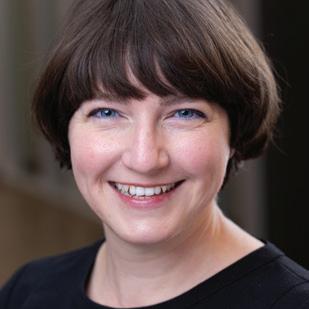
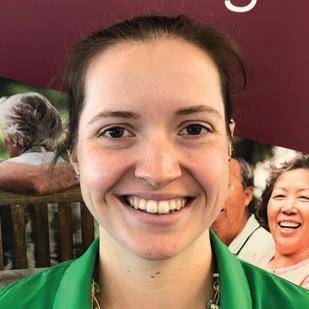
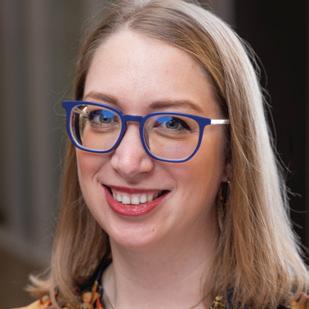
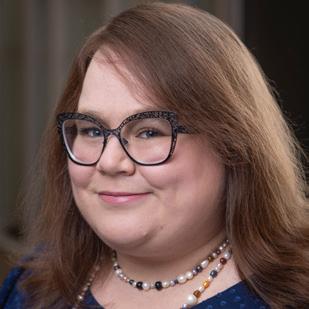
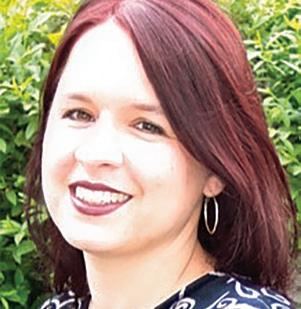
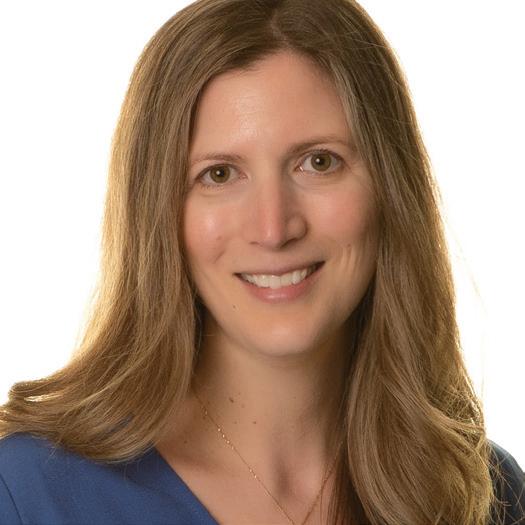


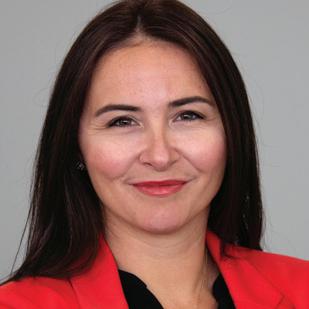
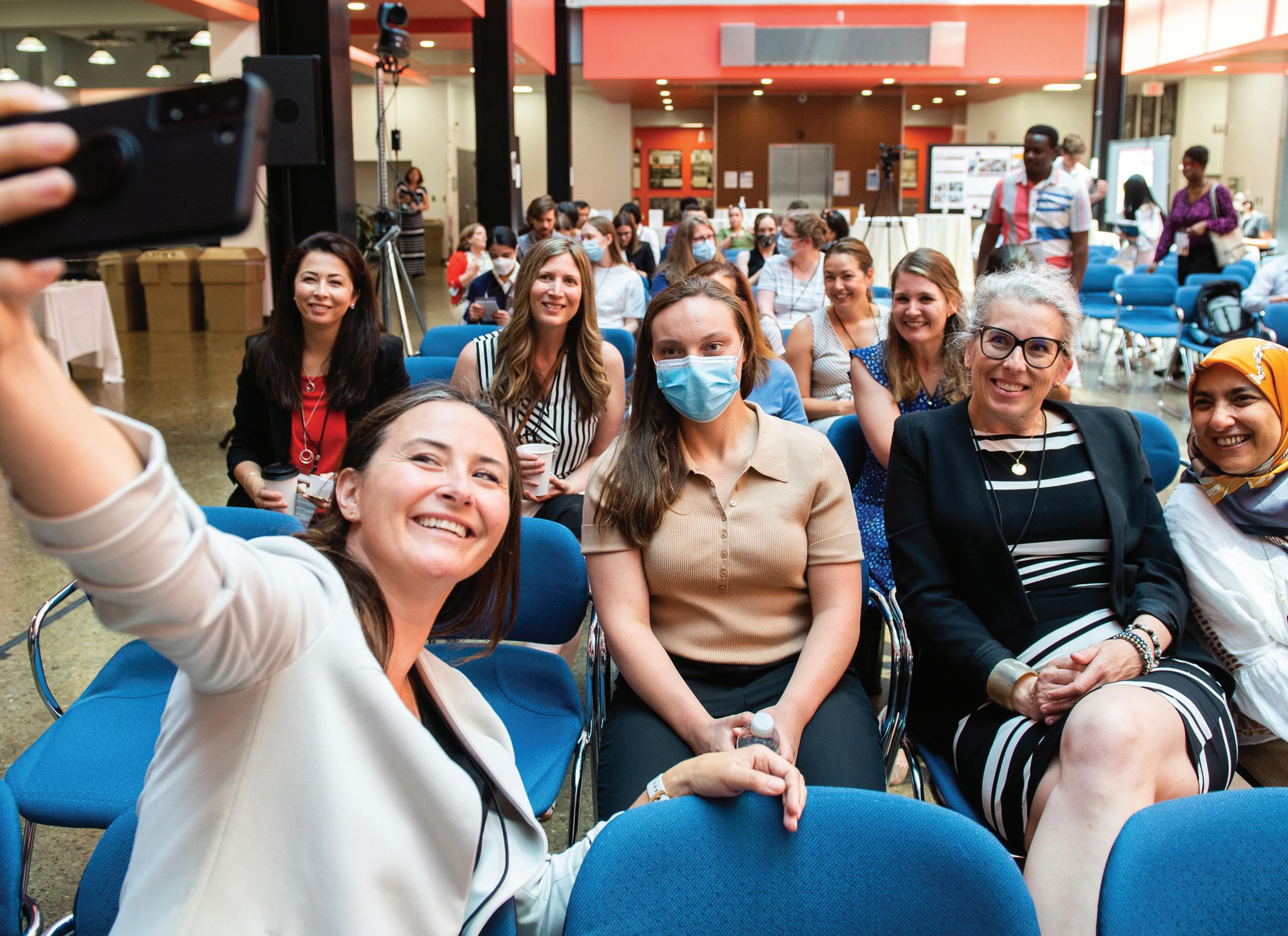
ABLE – Art Based therapies to encourage Longevity in Elderly participants
ACHRU – Aging, Community and Health Research Unit
AFU – Age-Friendly University
AGE-WELL – Aging Gracefully across Environments using Technology to Support Wellness, Engagement and Long Life NCE Inc.
ATTAIN – University of Birmingham-based research network aiming to develop effective and attainable physical activity interventions, and extend healthy life expectancy in communities that experience health inequalities
BCI – brain-computer interface
BMI – body mass index
BUS – DeGroote School of Business
CAB – Community Advisory Board
CAG – Canadian Association on Gerontology
CAN Thumbs Up – Canadian Therapeutic Platform Trial for Multidomain Interventions to Prevent Dementia
CFN – Canadian Frailty Network
CFREF – Canada First Research Excellence Fund
CIHR – Canadian Institutes of Health Research
CLSA – Canadian Longitudinal Study on Aging
CMC – corticomuscular coherence
CNP – chronic neck pain
Co-I – co-investigator
Co-PI – co-principal investigator
COVID-19 – coronavirus disease 2019
CP@clinic – Community Paramedicine at Clinic
DELI – Division of E-Learning and Innovation
DRL – deep reinforcement learning
EMBOLDEN – The EMBOLDEN trial: Enhancing physical and community MoBility in OLDEr adults with health inequities using commuNity codesign of a complex intervention incorporating exercise, nutrition, social participation and system navigation
EMP – early mobility programs
ENG – Faculty of Engineering
EPIC-AT – Early Professionals, Inspired Careers in AgeTech
FHS – Faculty of Health Sciences
GERAS DANCE – therapeutic mind-body program for older adults (aged 60+) developed with rehabilitation and geriatric medicine expertise at the GERAS Centre for Aging Research at Hamilton Health Sciences and McMaster University
GLA-D – Good Living with Arthritis in Denmark
GTHA – Greater Toronto, Hamilton Area
HQP – highly qualified personnel — research staff (assistants, technicians, coordinators, etc.) and trainees
HPL – Hamilton Public Library
HUM – Faculty of Humanities
ICU – intensive care unit
IMBED – Integrated Musculoskeletal BiofEedback Device
IMPACT – Investigating Mobility and Participation among Older Hamiltonians during COVID-19: A Longitudinal Tele-Survey
IPRC – Michael G. DeGroote Institute for Pain Research and Care
ISAC – International Scientific Advisory Committee
IT – information technology
KOA – knee osteoarthritis
LCMA – Labarge Centre for Mobility in Aging
LOAI – Labarge Optimal Aging Initiative
LSA – Life-Space Assessment
MacM3 – McMaster Monitoring My Mobility
MAPS-B – Mapping Sedentary Behaviour
MCE – McMaster Continuing Education
MIRA – McMaster Institute for Research on Aging
MIRA-iGeN – an intergenerational and life course program of research
MIRI – McMaster Indigenous Research Institute
MIP – McMaster Innovation Park
MRI – magnetic resonance imaging
NICA – National Innovation Centre for Ageing
NSERC – Natural Sciences and Engineering Research Council of Canada
OA – osteoarthritis
OPA – Optimal Aging Portal
PET – positron emission tomography
PHAC – Public Health Agency of Canada
PI – principal investigator
PIHCI – Primary and Integrated Health Care Innovations
proNGF – pro-nerve growth factor
QEP – qualified exercise professional
RAPPID – Readying Aging Populations for Pandemics and Infectious Disease
RBG – Royal Botanical Gardens
RGDI – Race, Gender and Diversity Initiative
SARS-CoV-2 – severe acute respiratory syndrome
coronavirus 2
SCI – Faculty of Science
SGC – Strategic Guiding Council
SOSCI – Faculty of Social Sciences
SPOR – Strategy for Patient-Oriented Research
SSHRC – Social Sciences and Humanities Research Council
TrkA – tropomyosin-related kinase A
TNF – tumour necrosis factor
Voice – a passionate community of members of the public, patients and carers who contribute their unique individual experiences to improve research & innovation
WHO – World Health Organization
